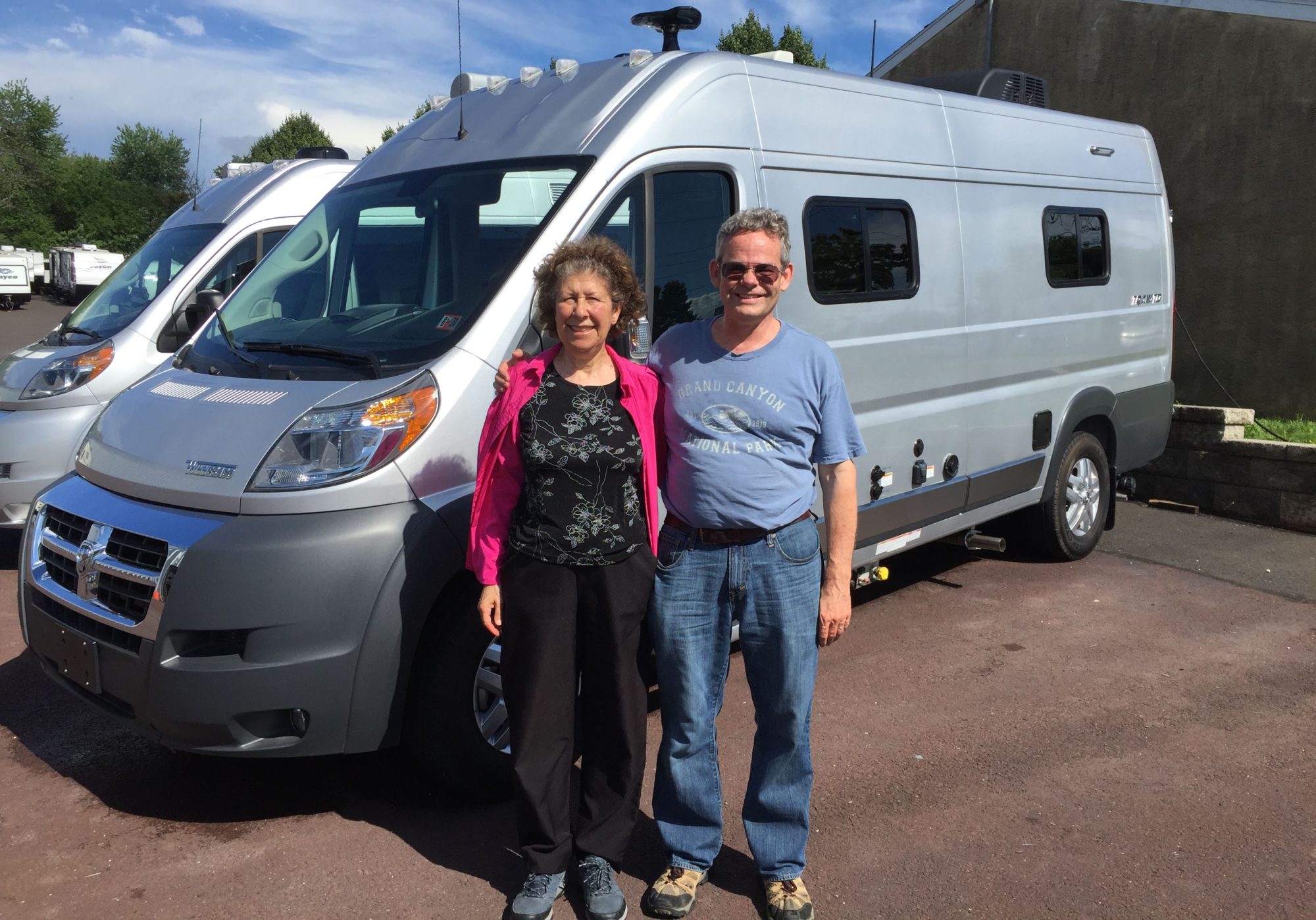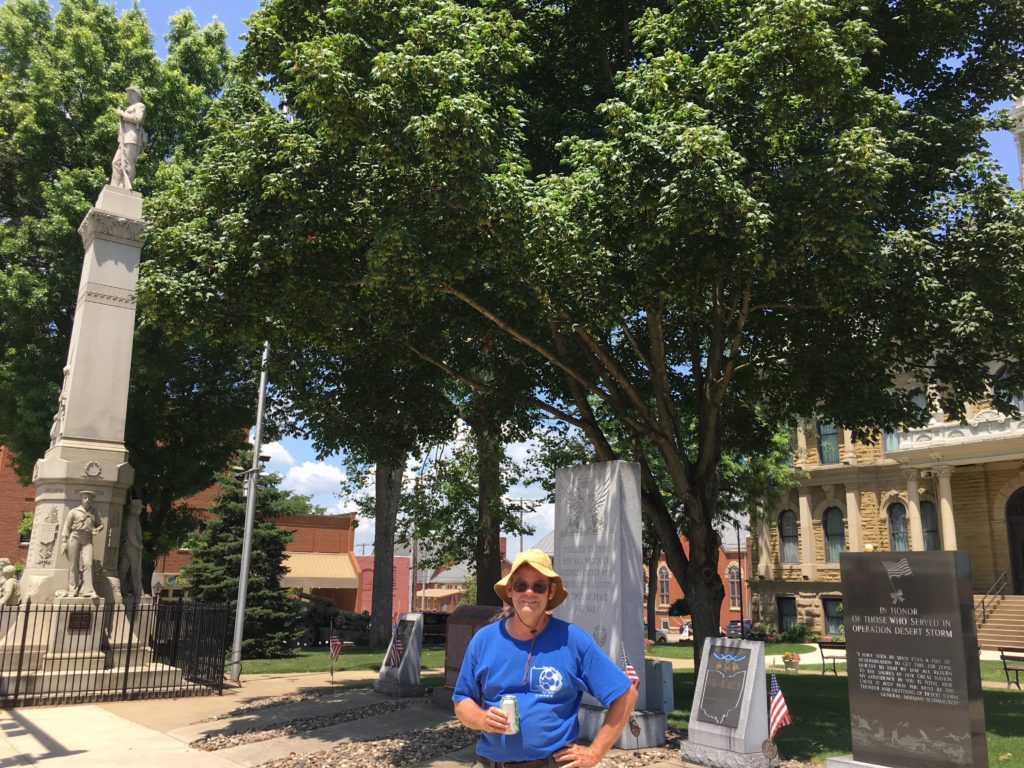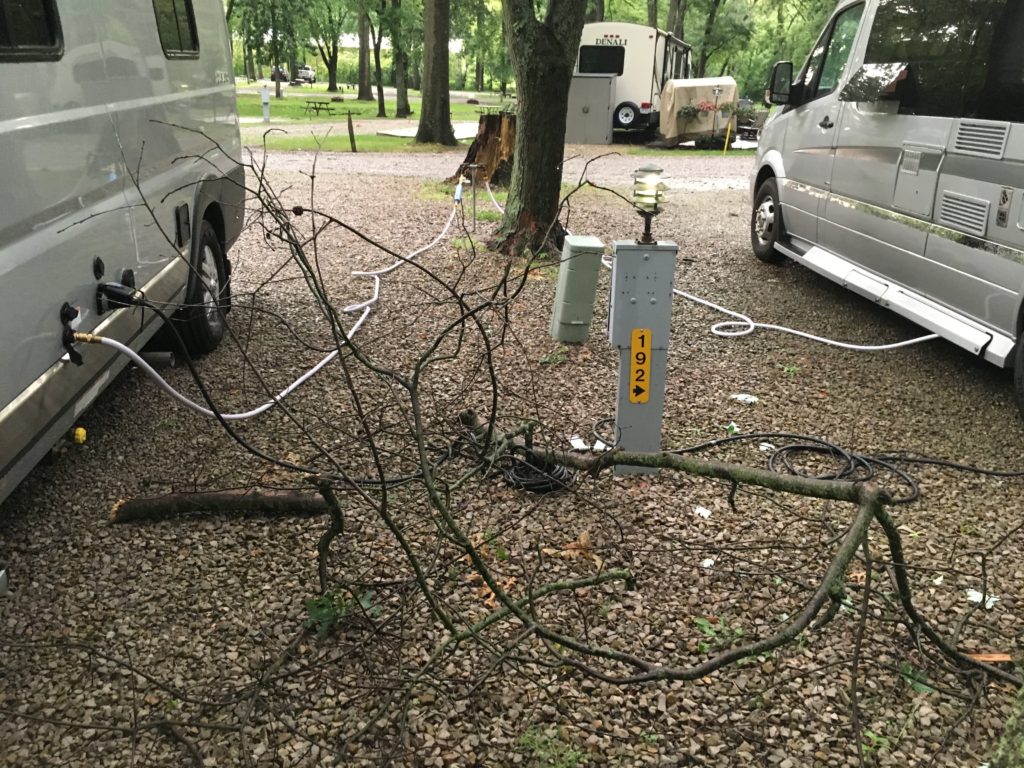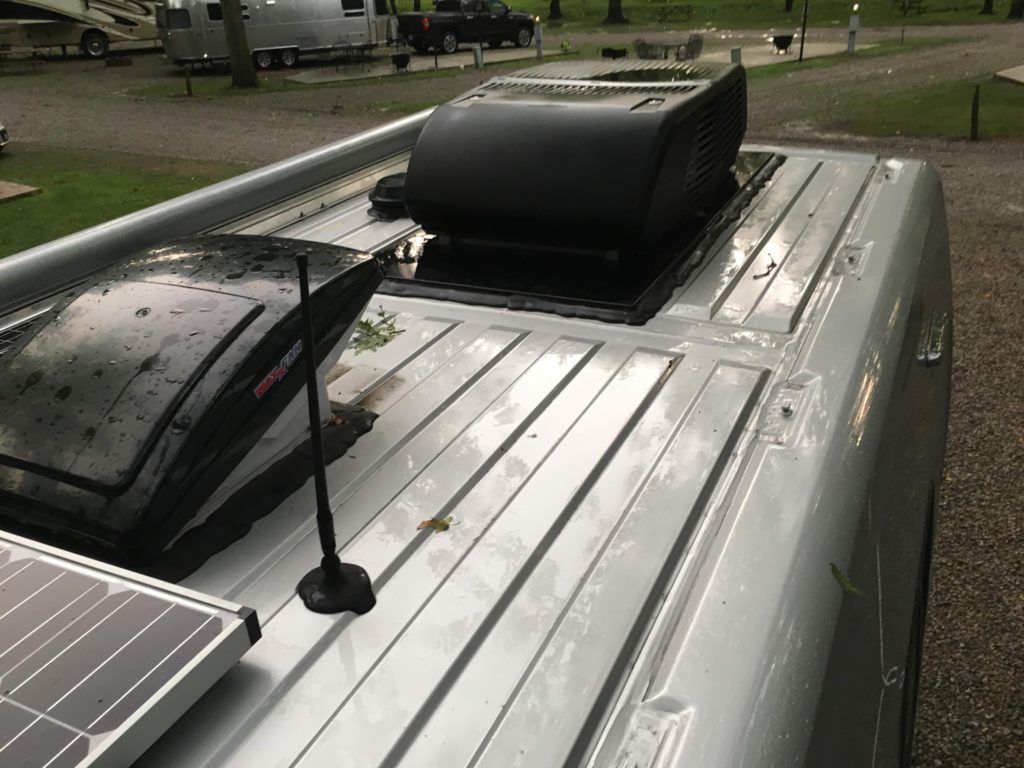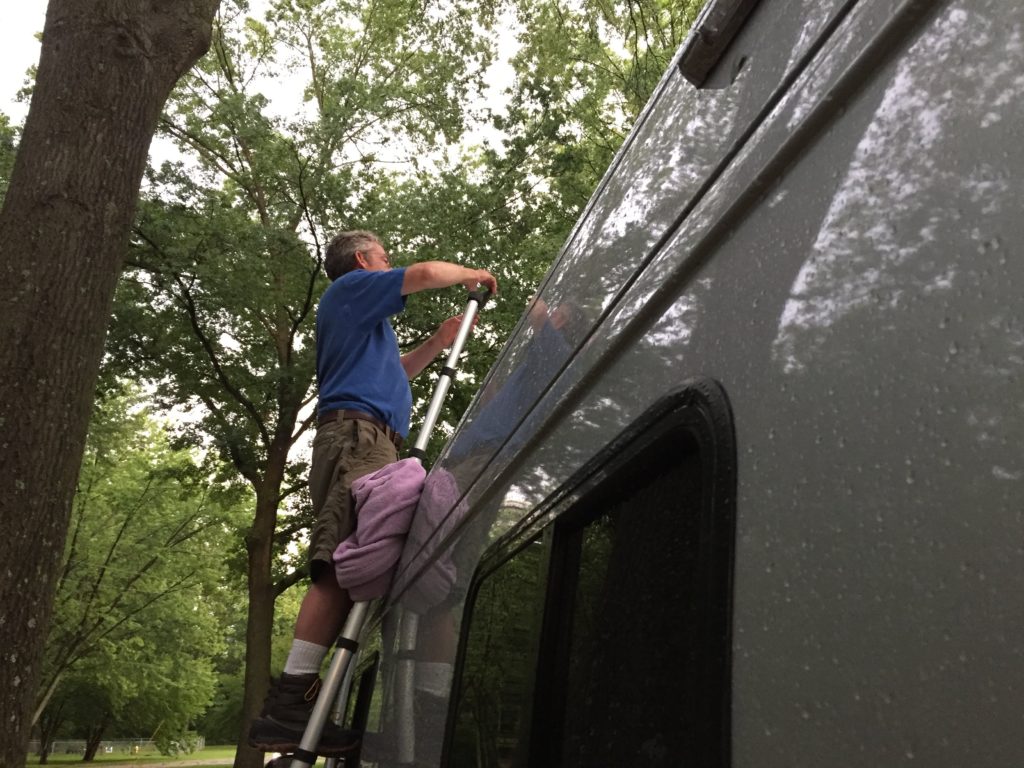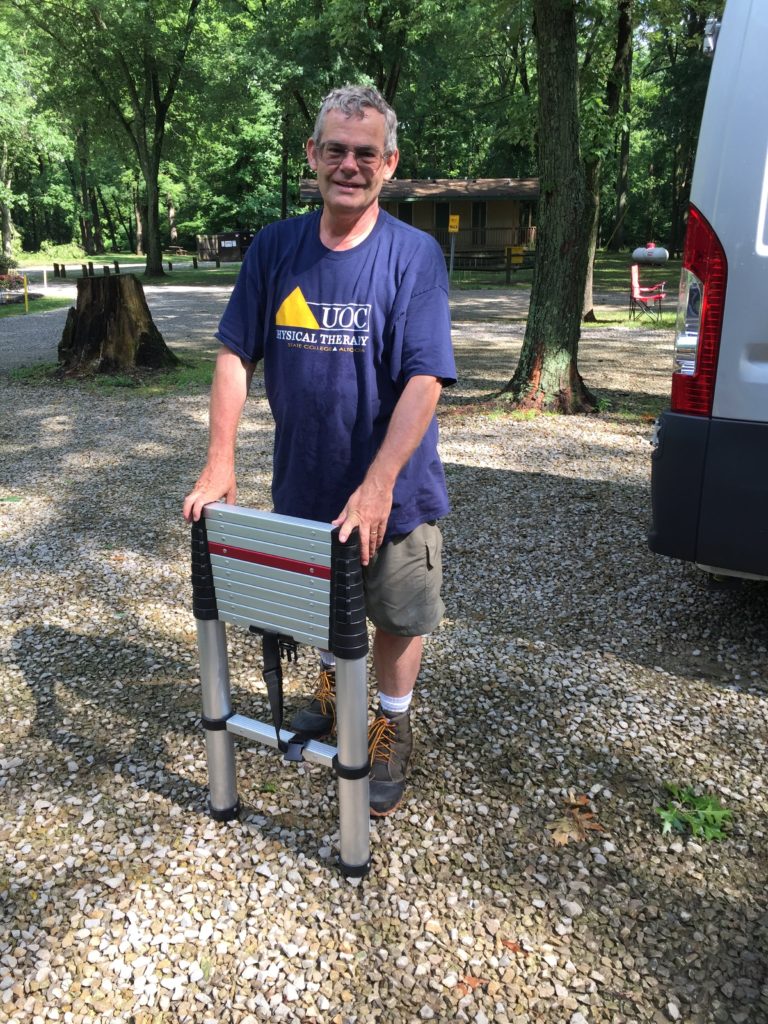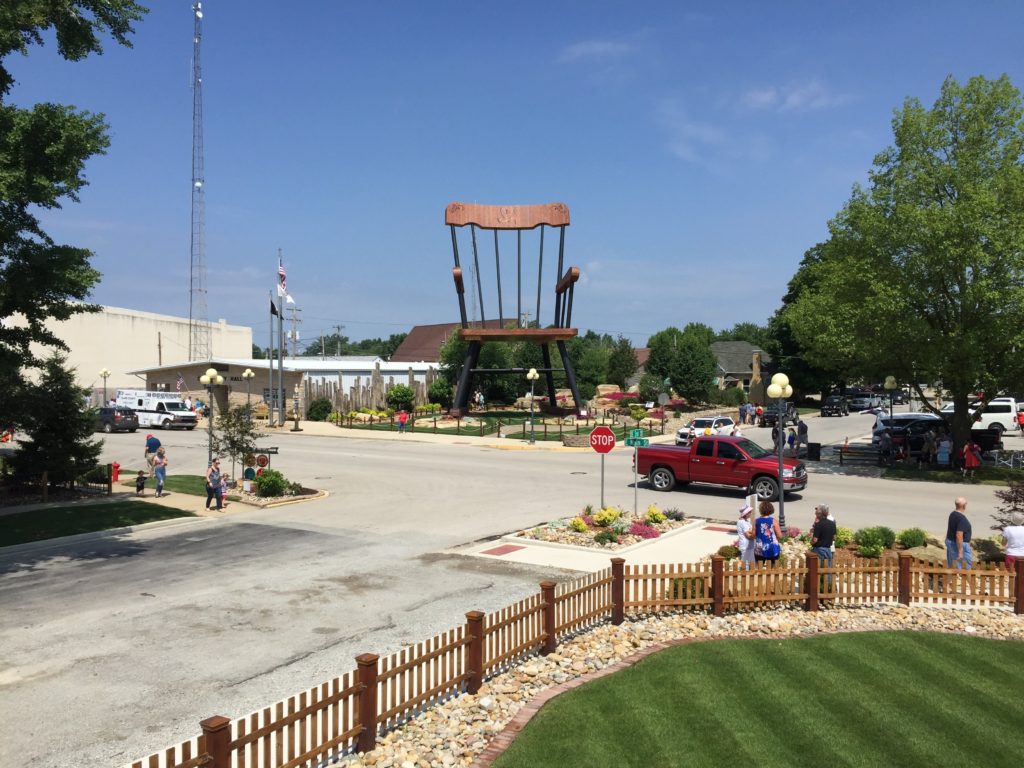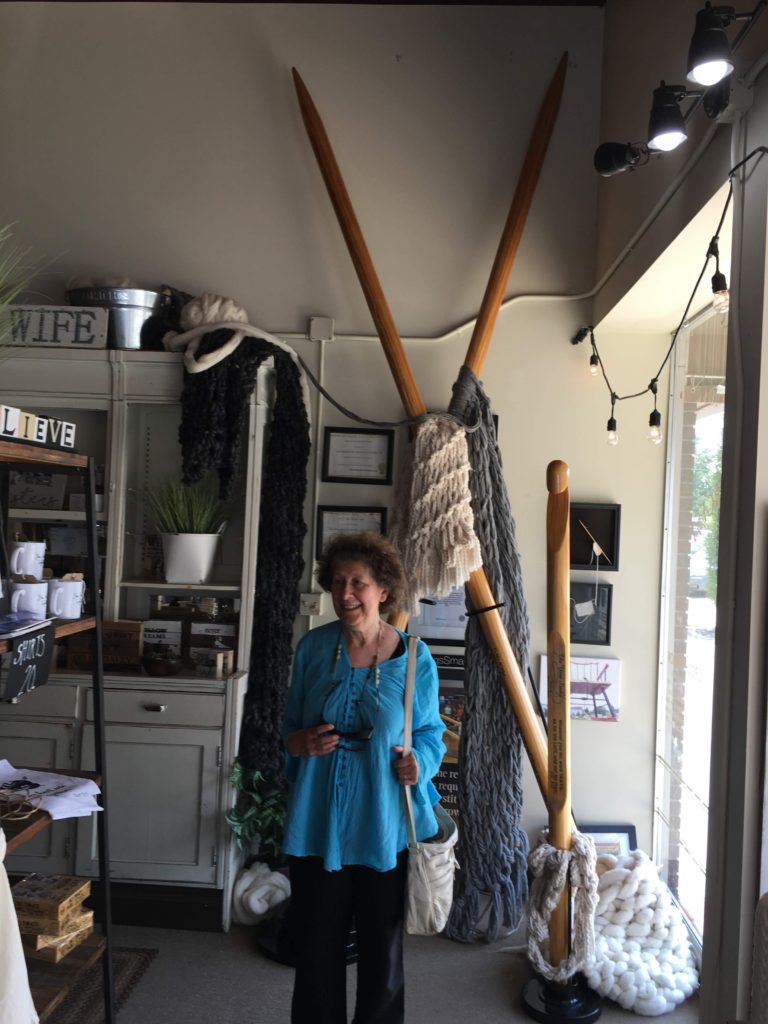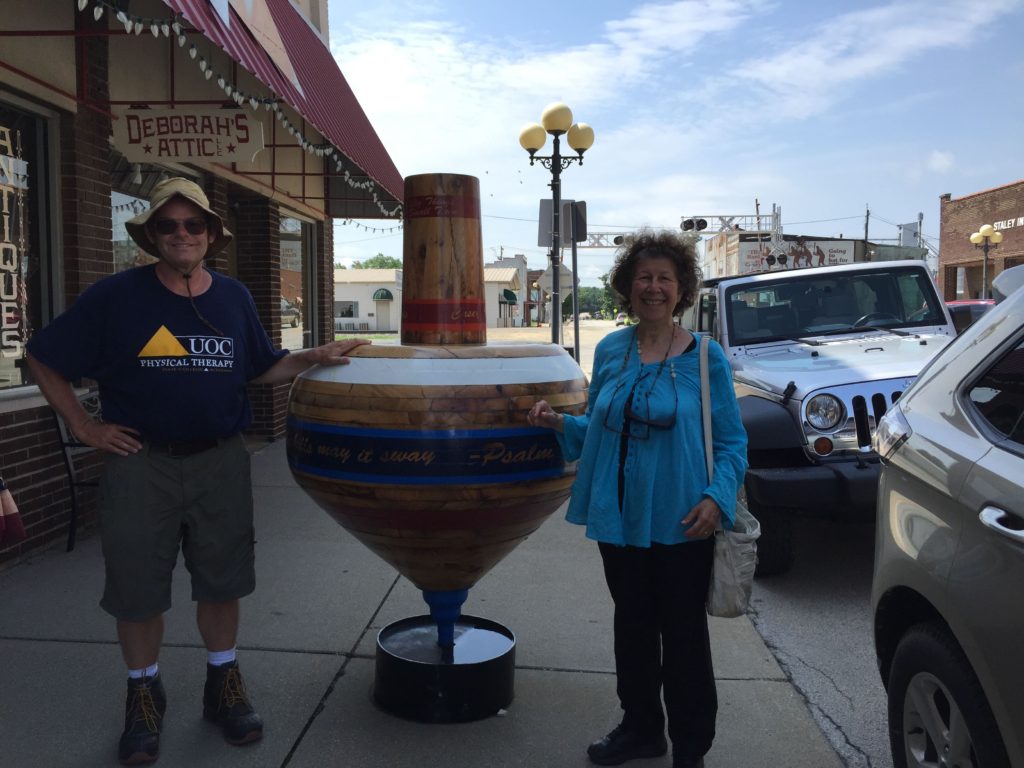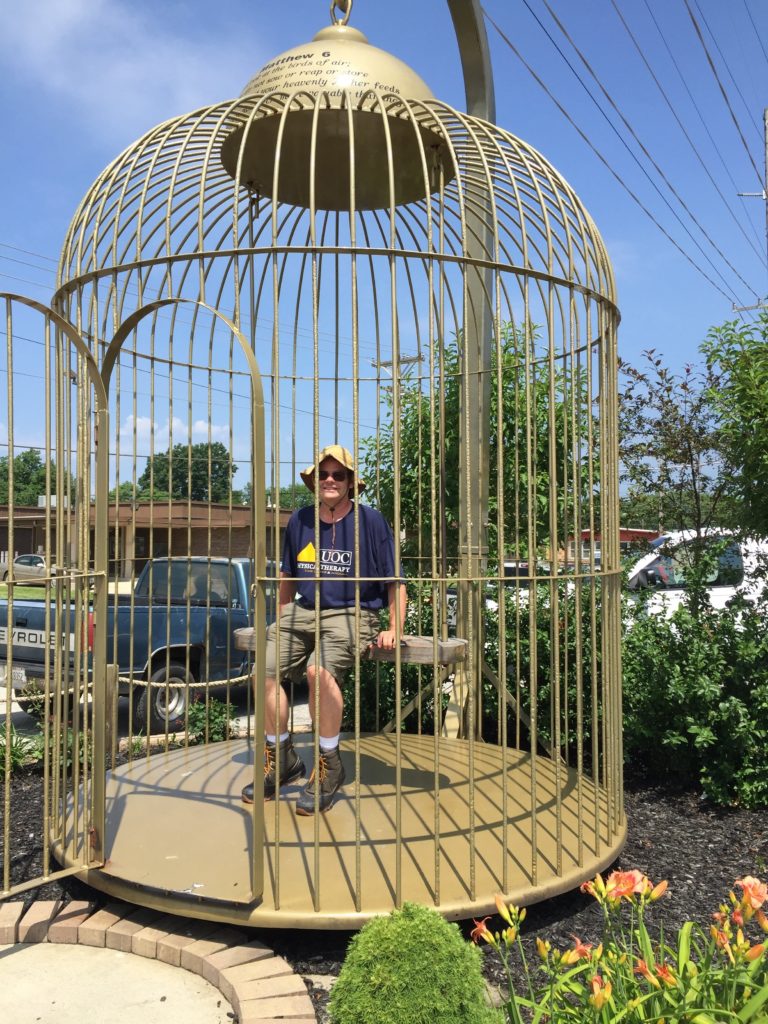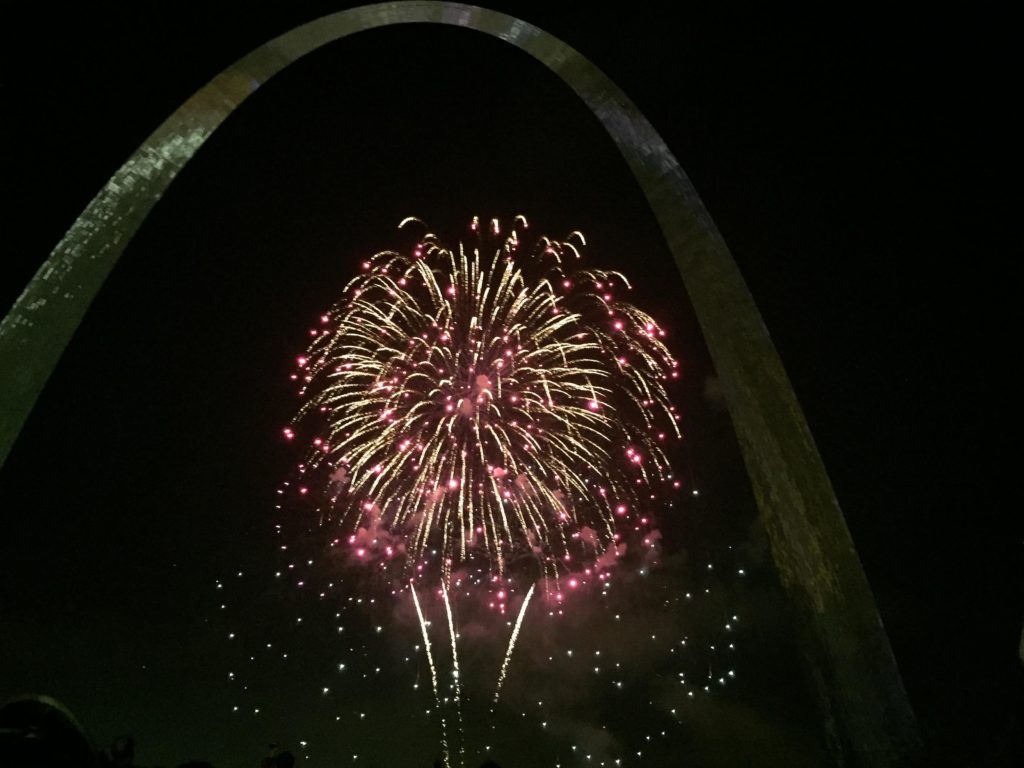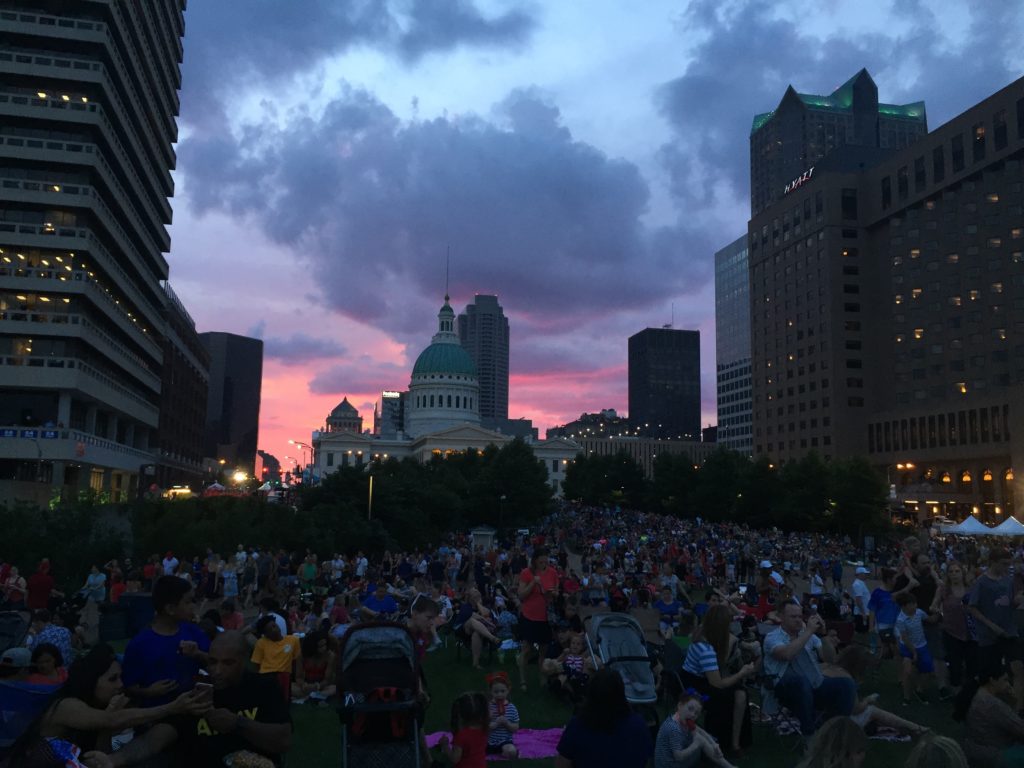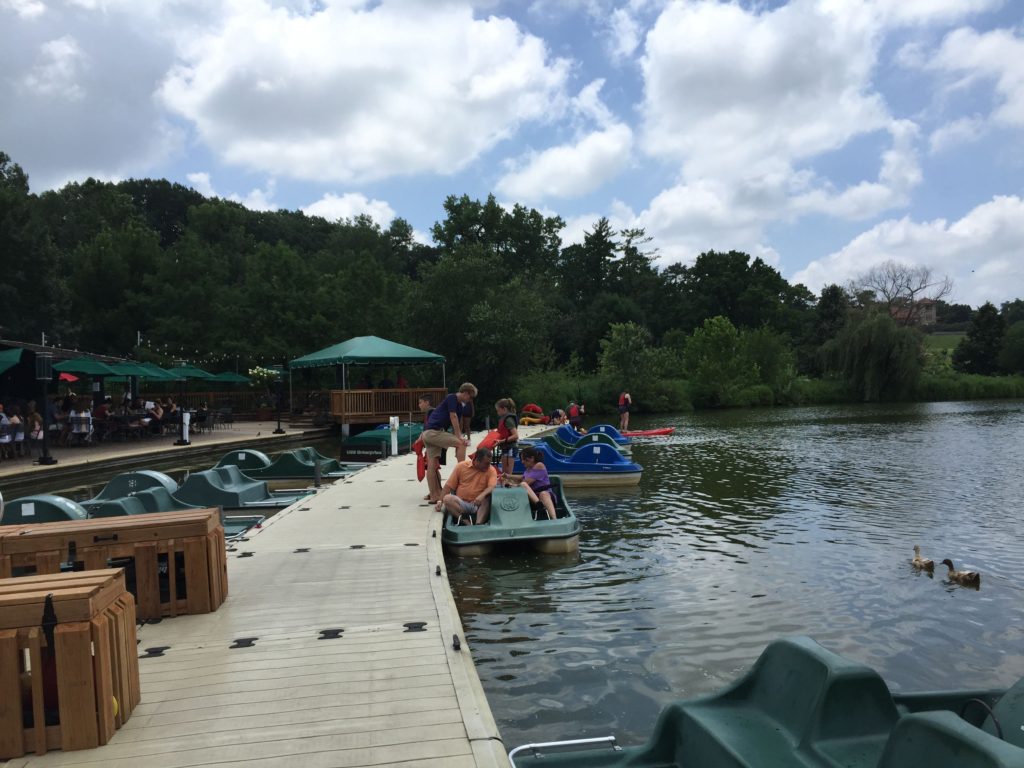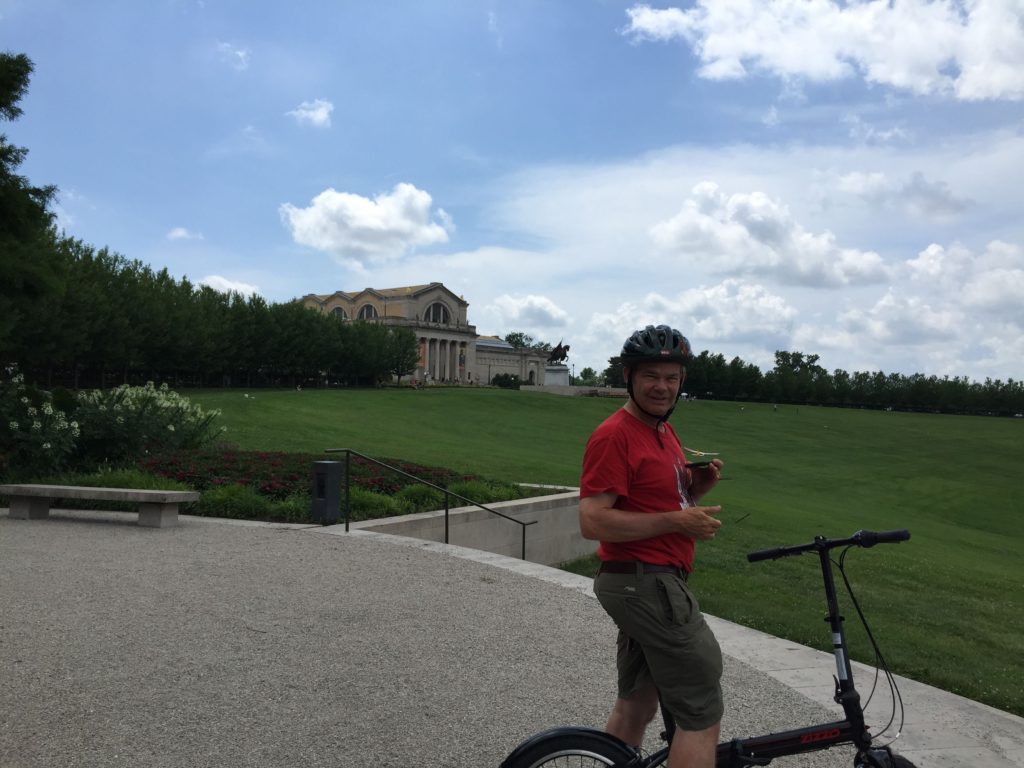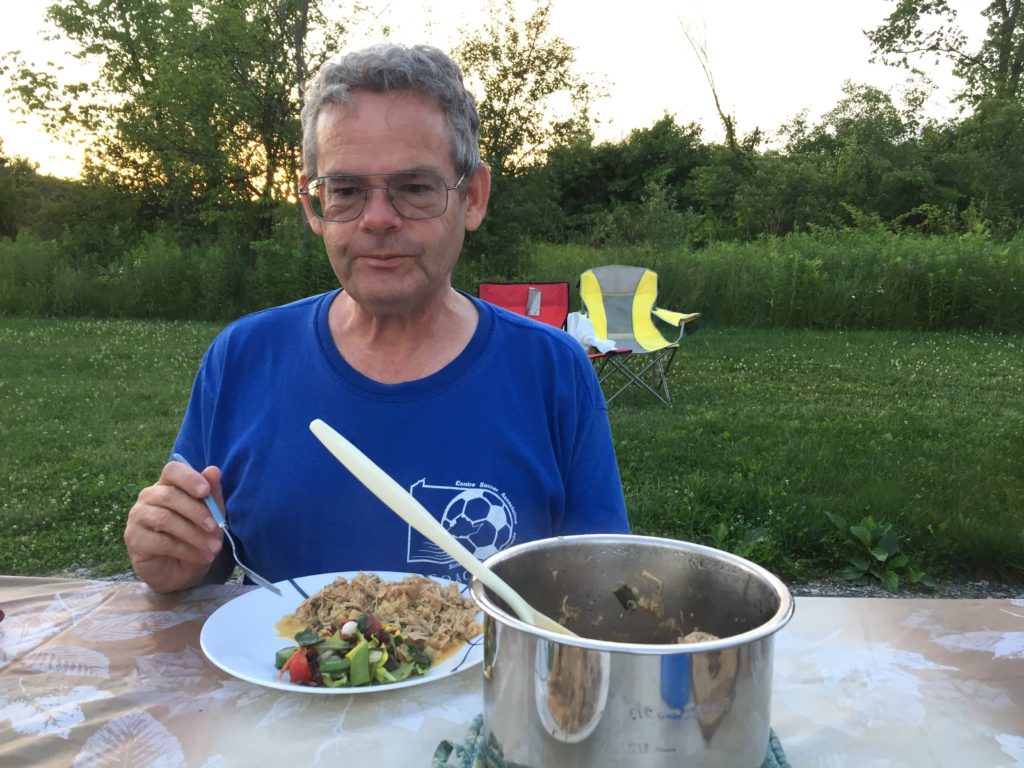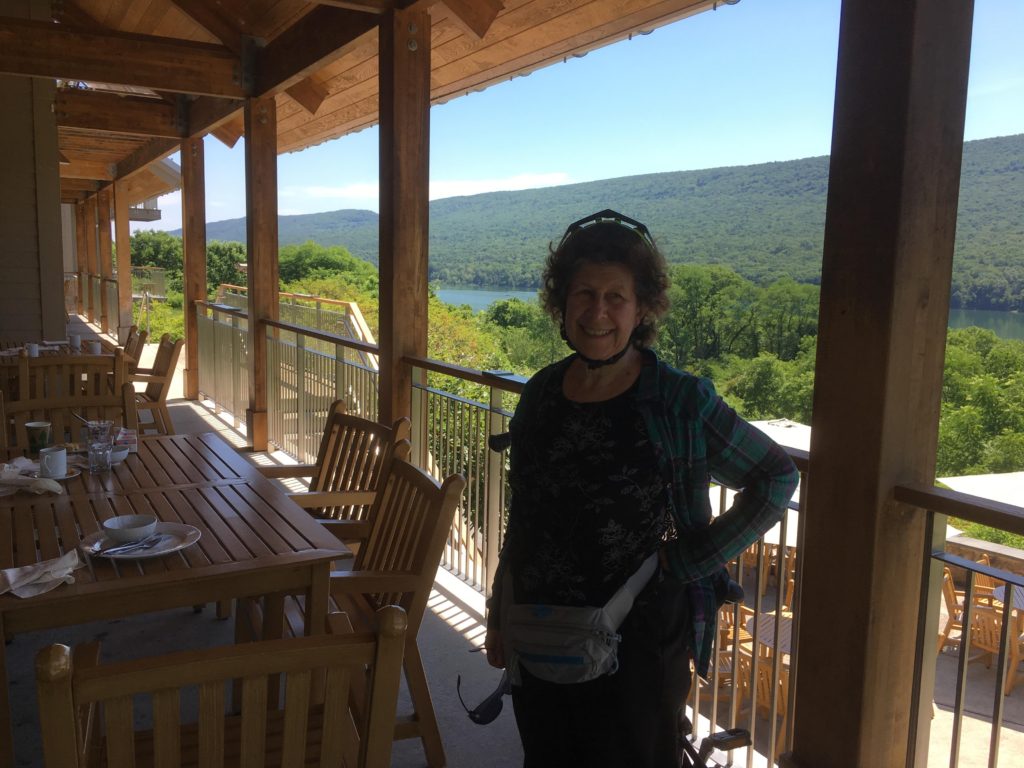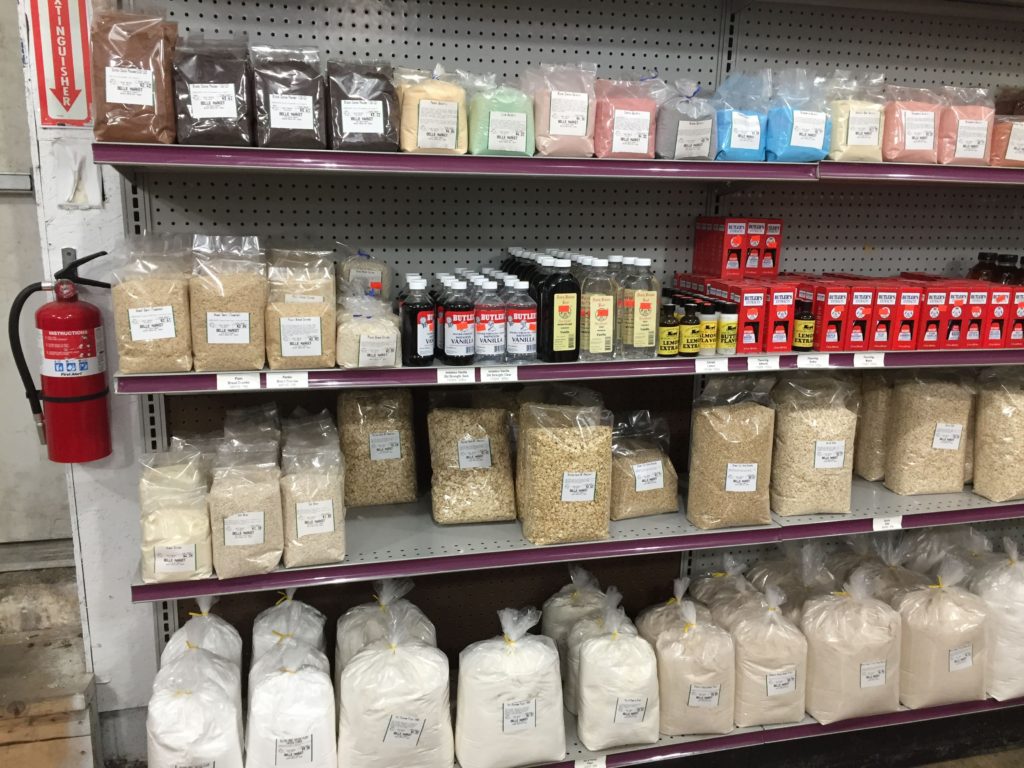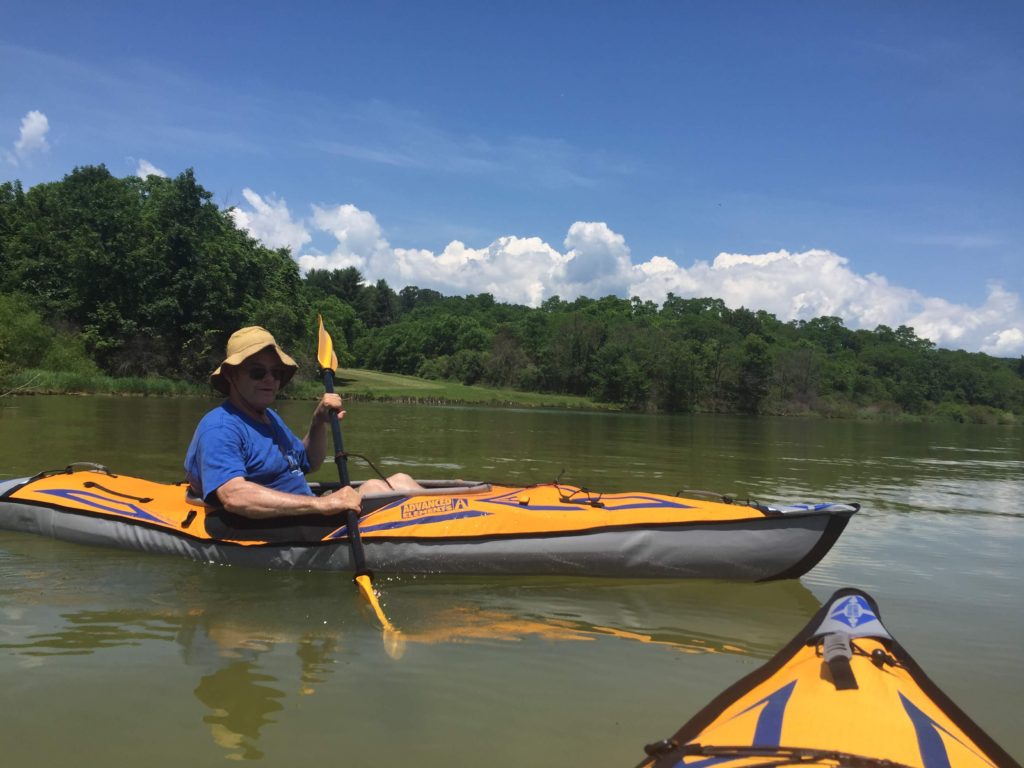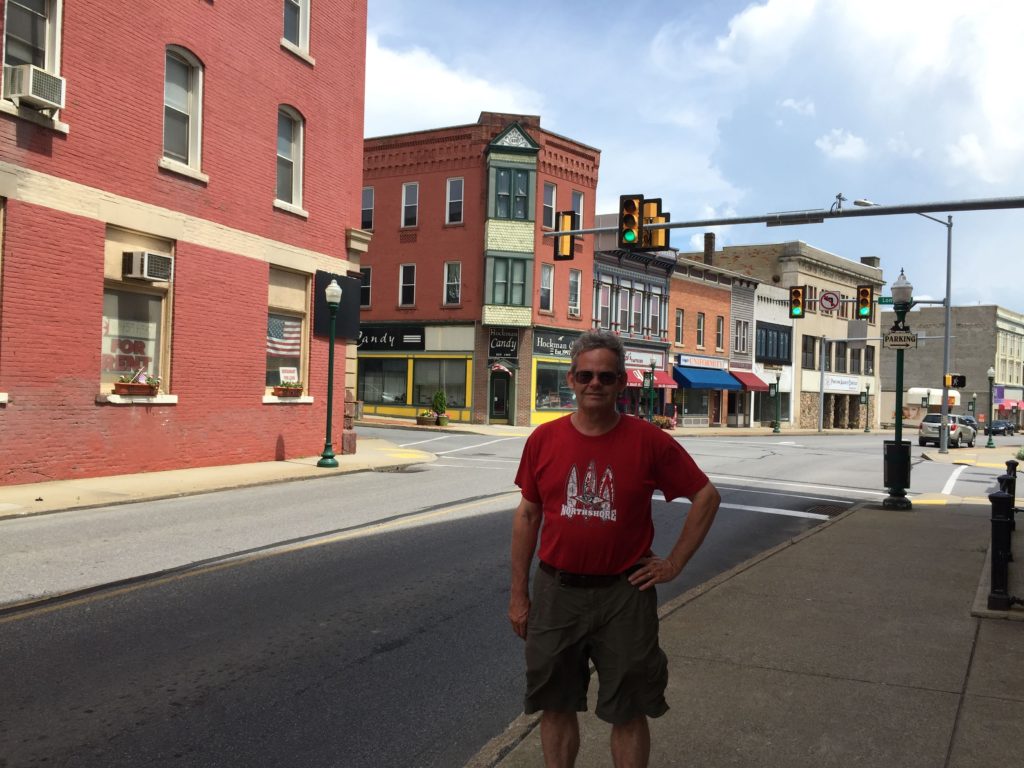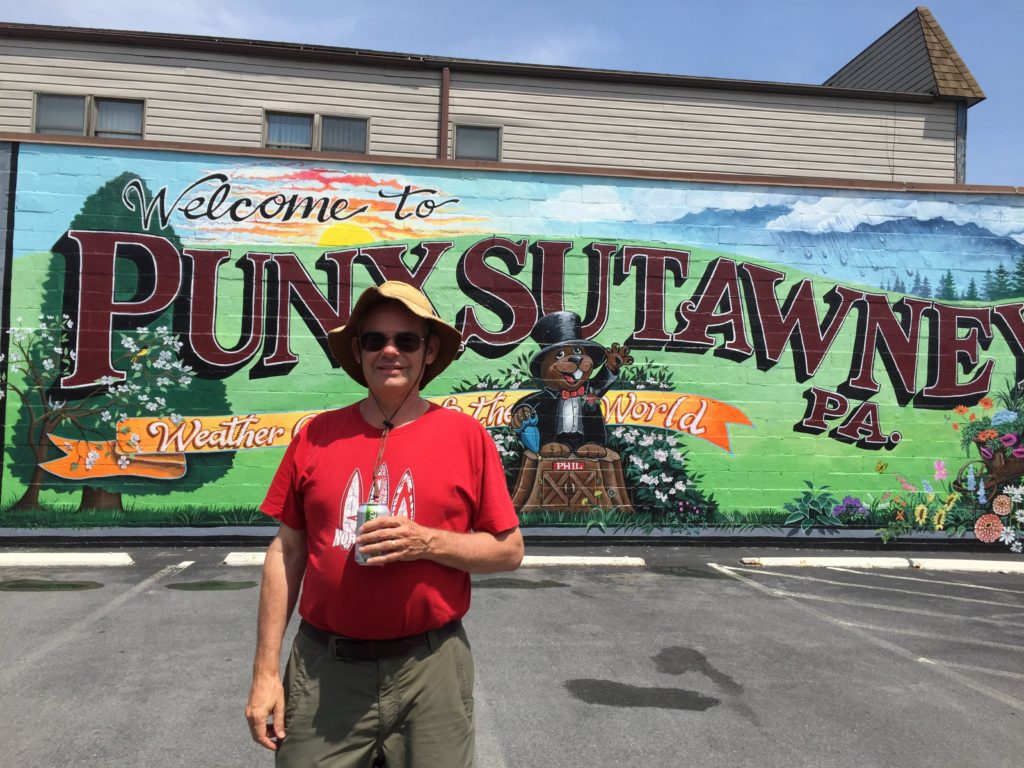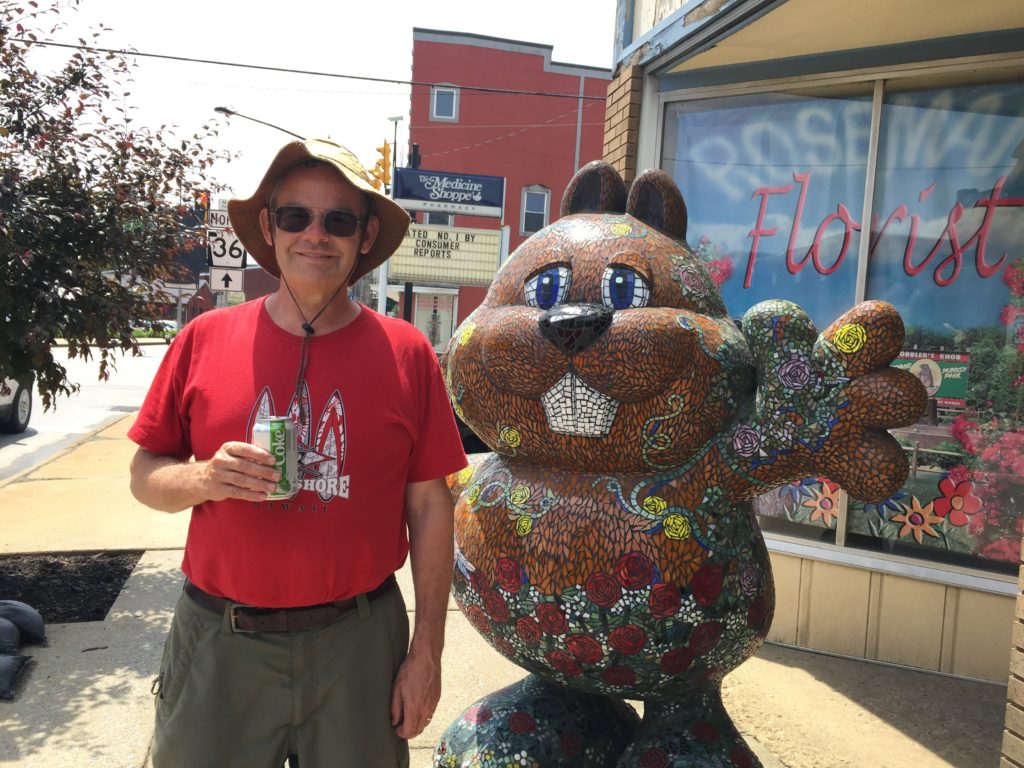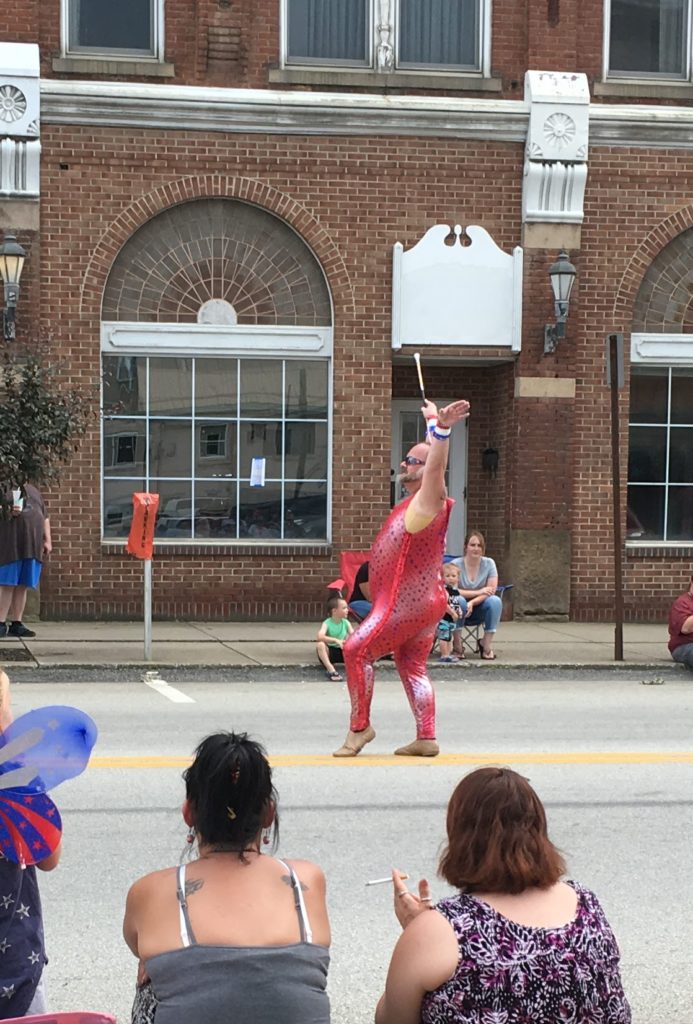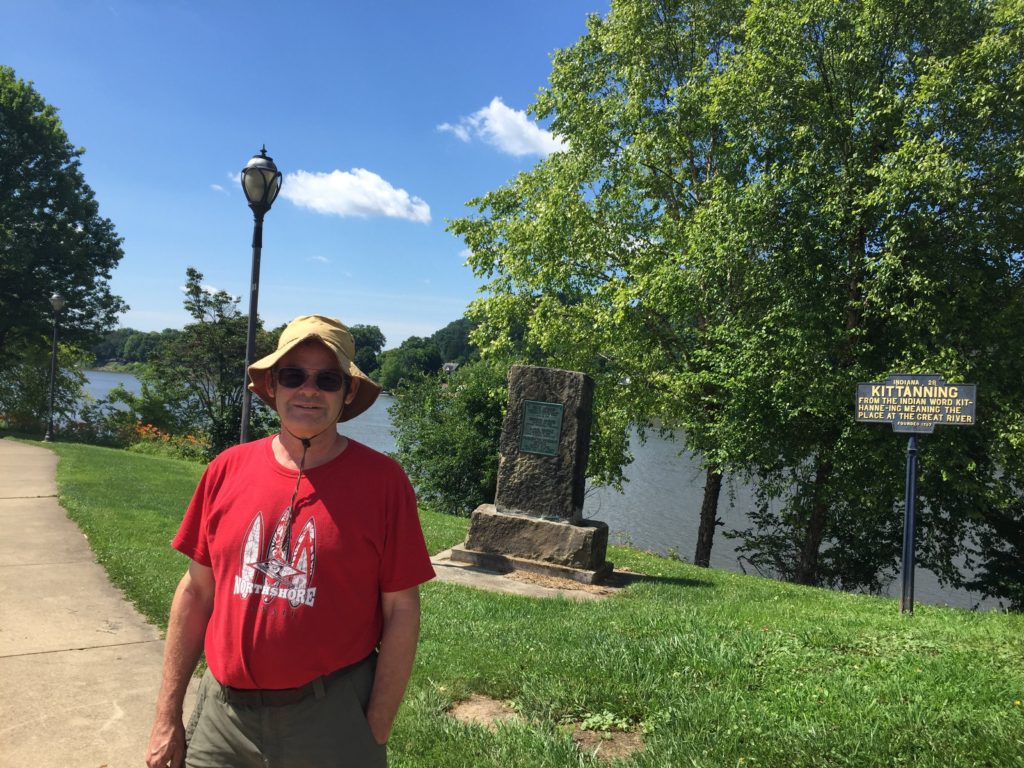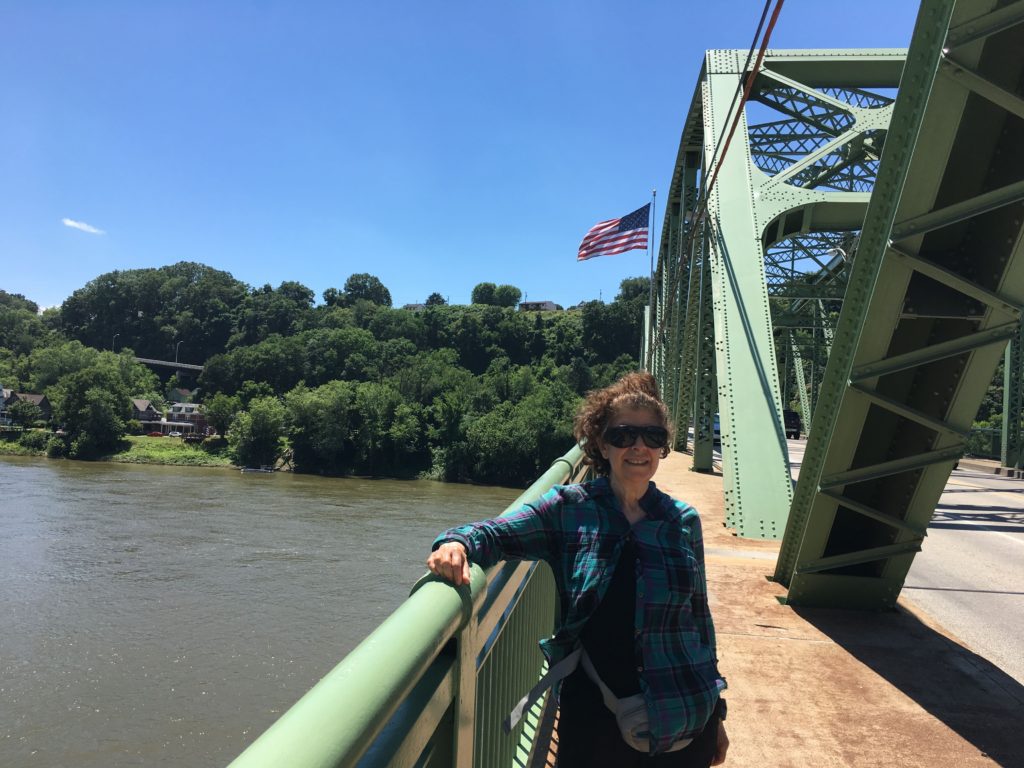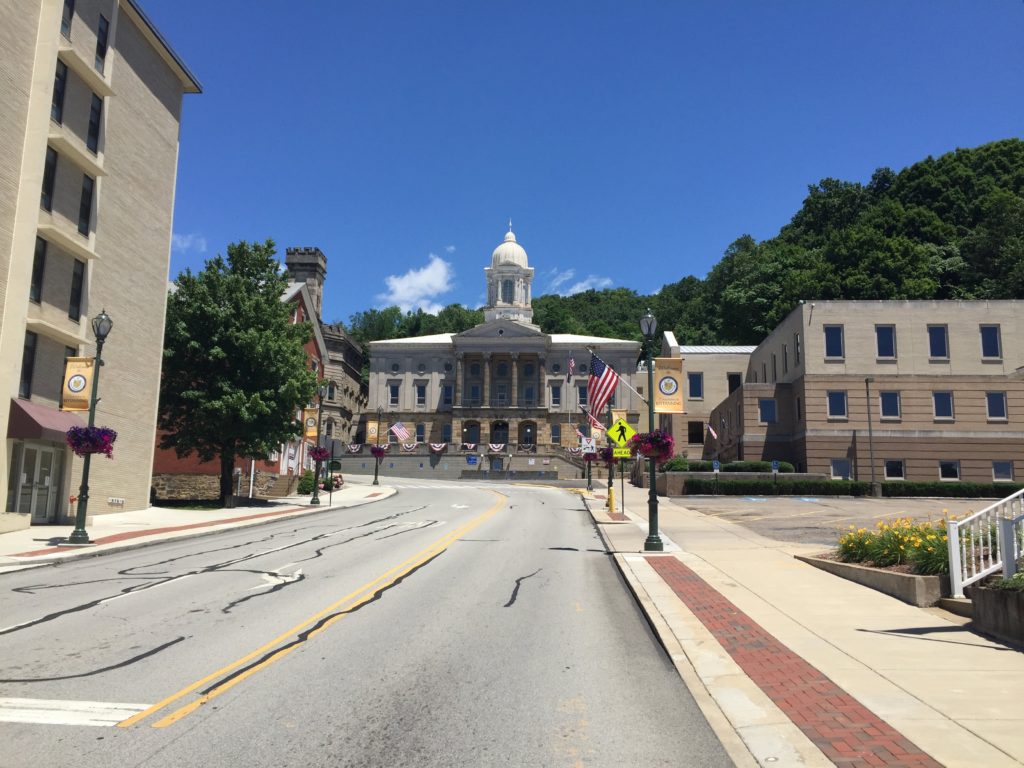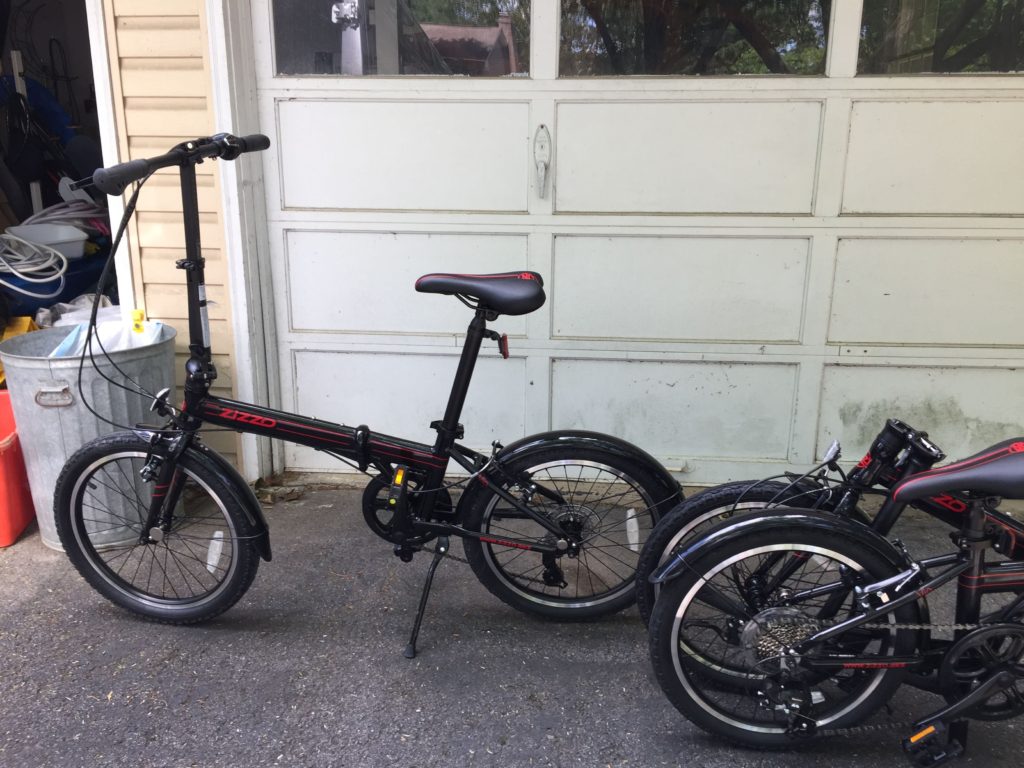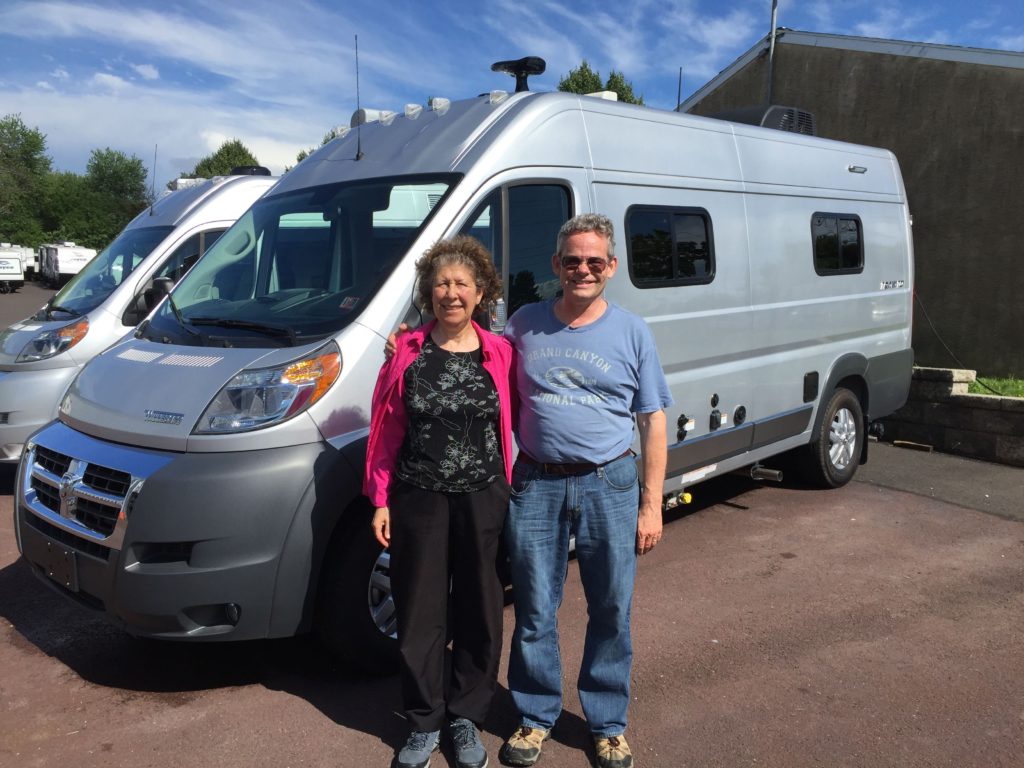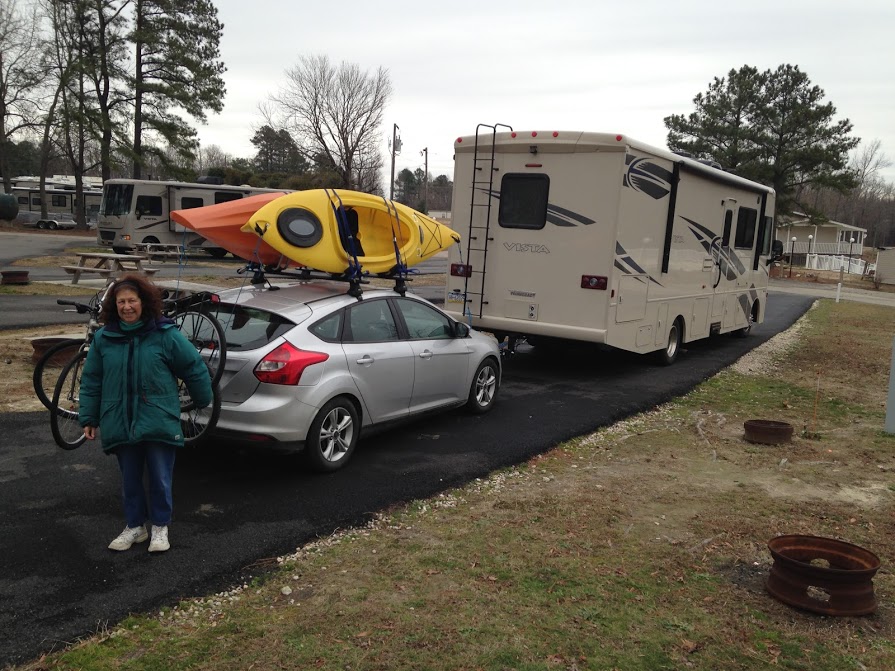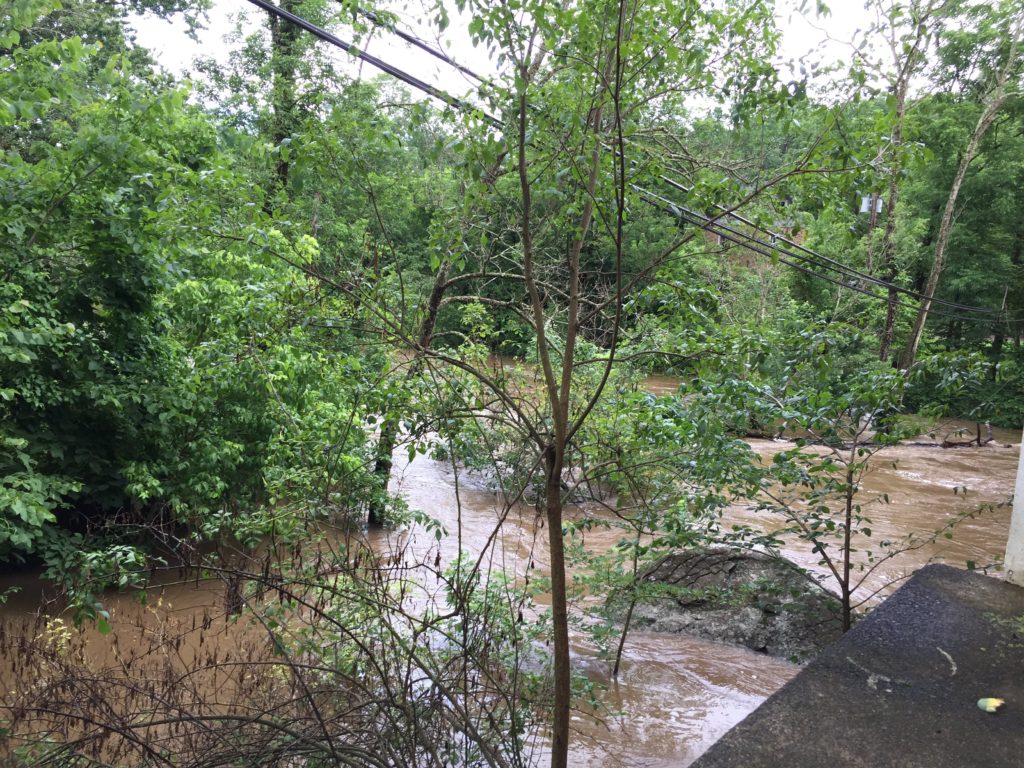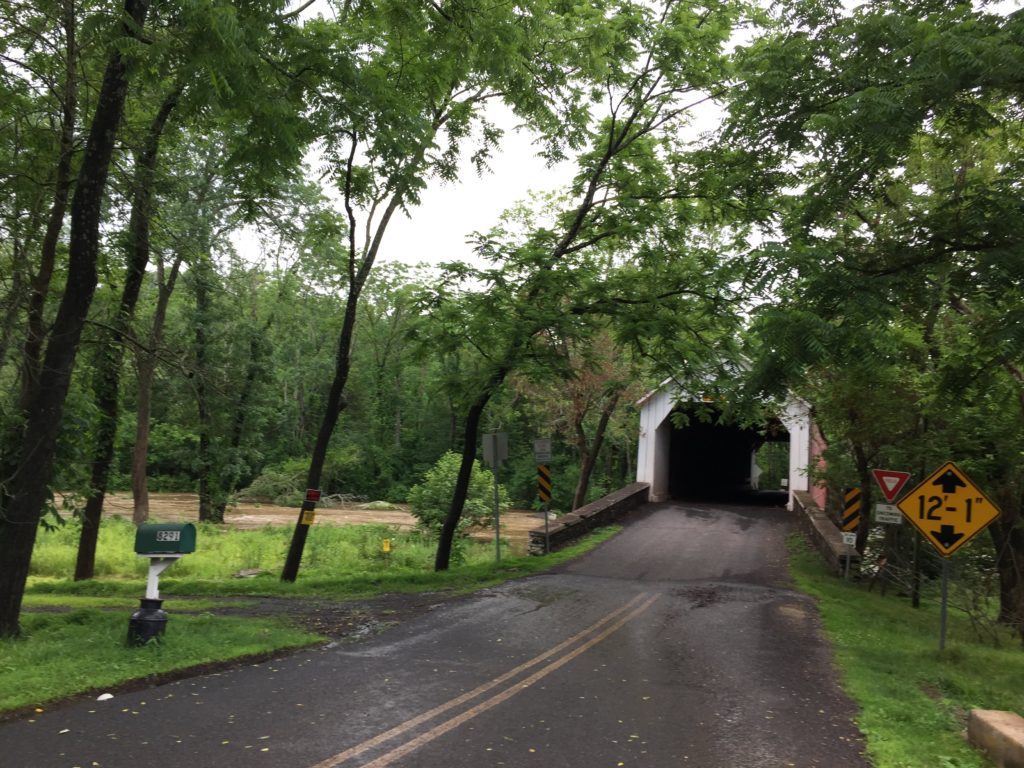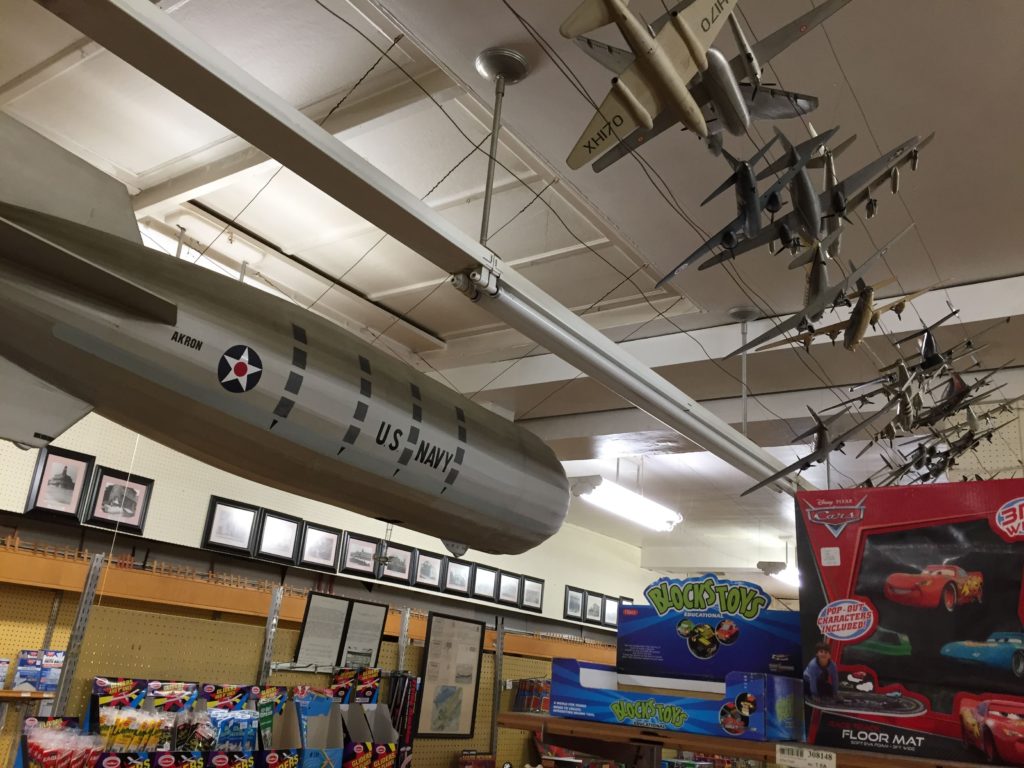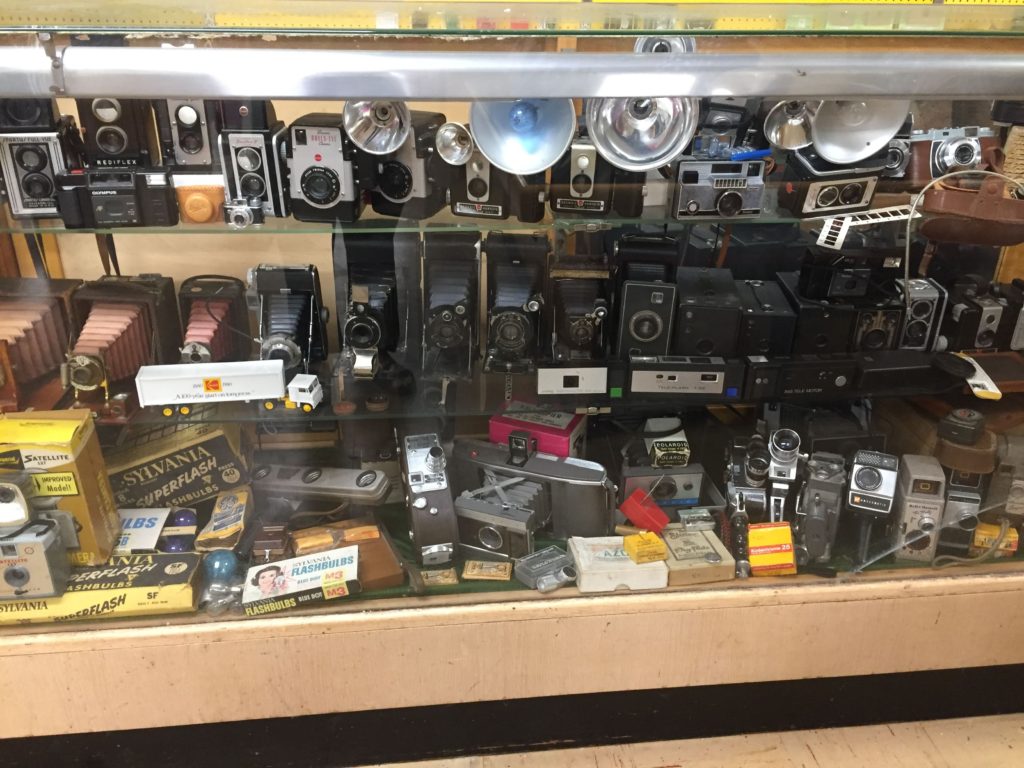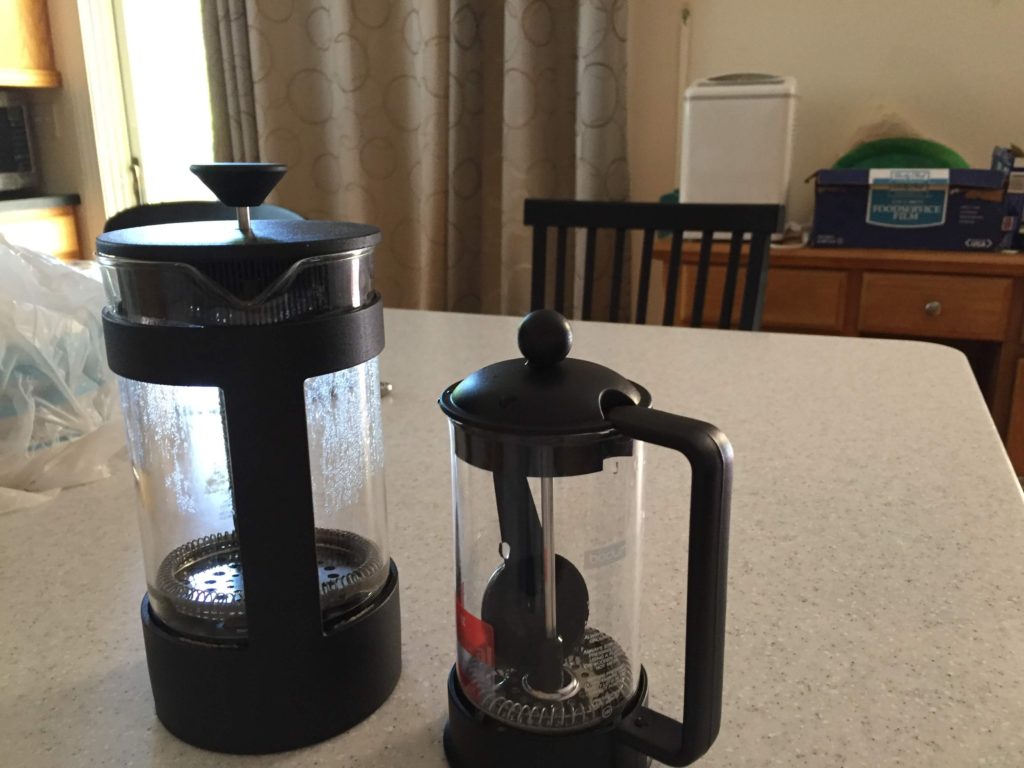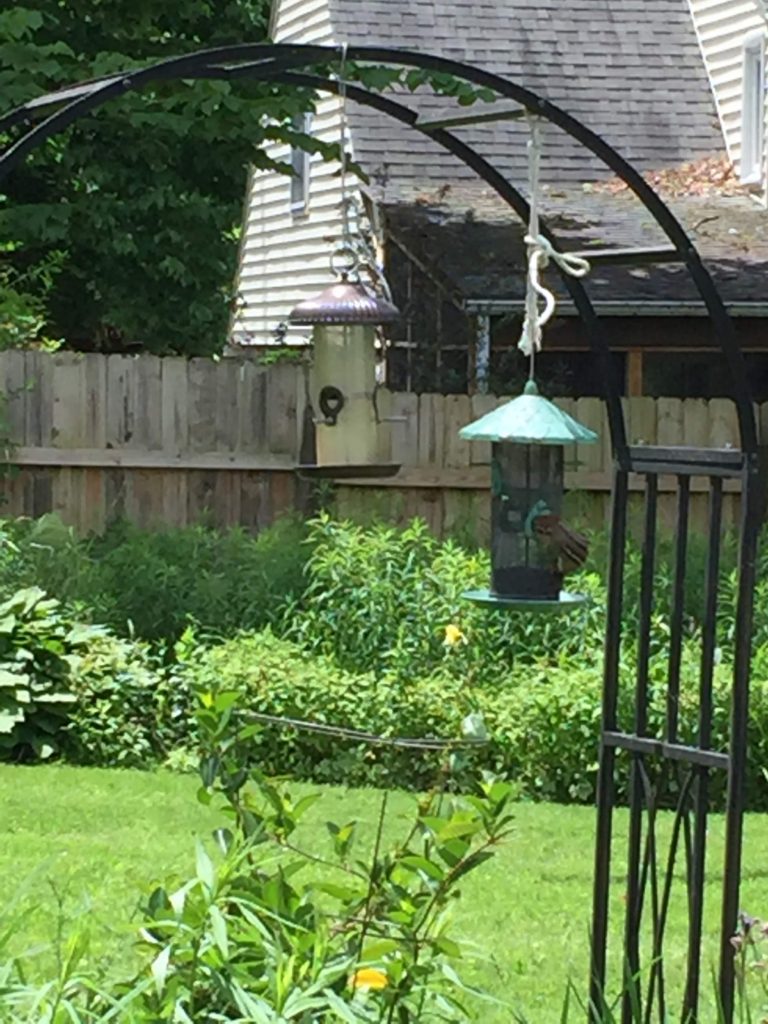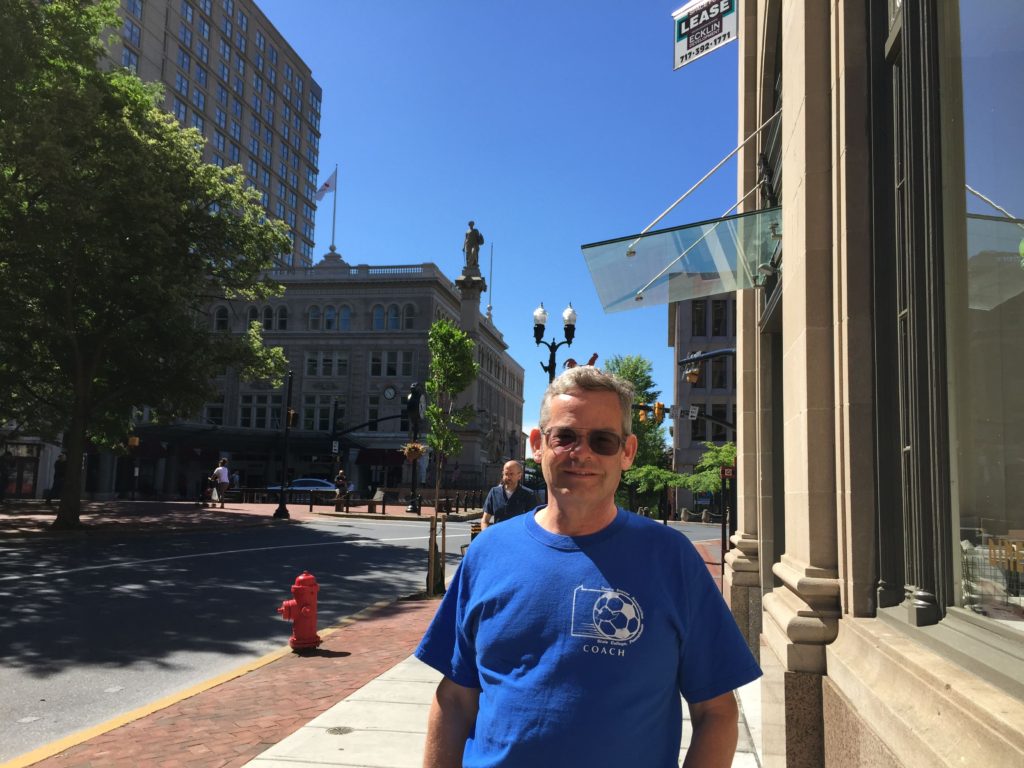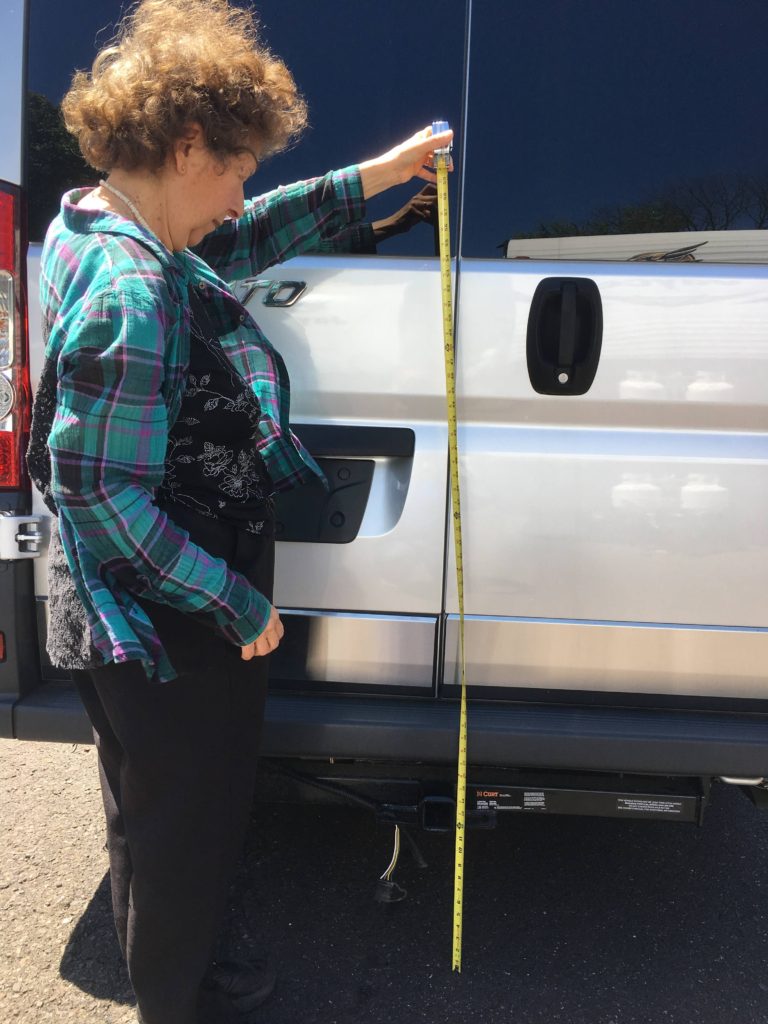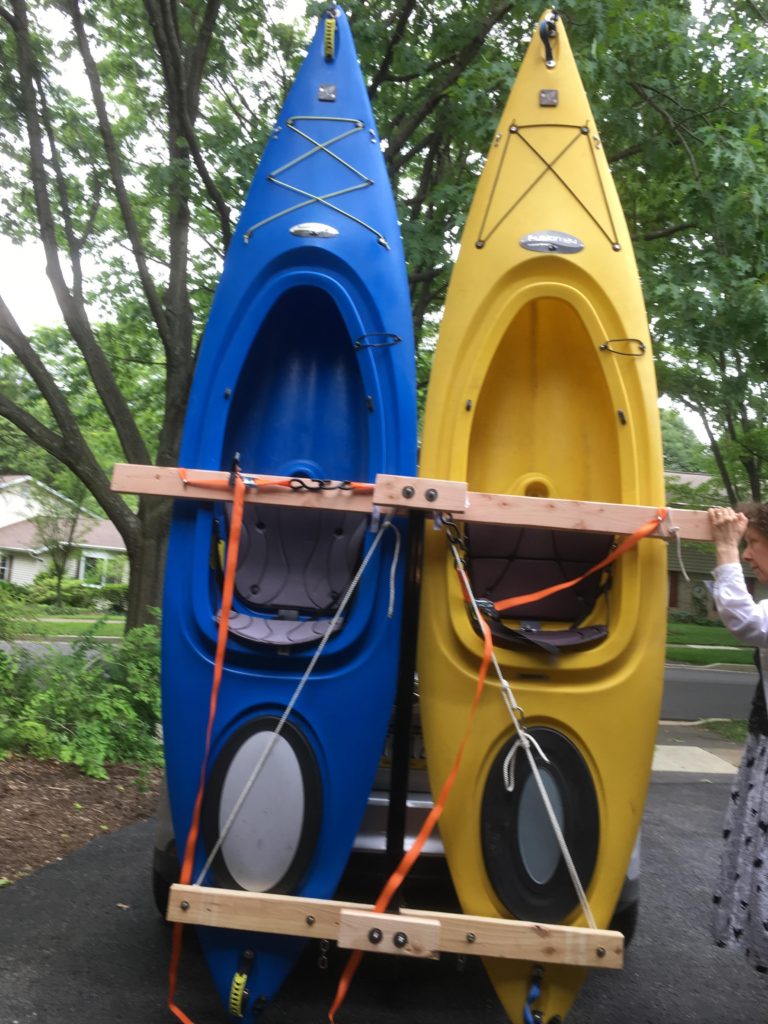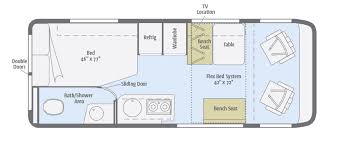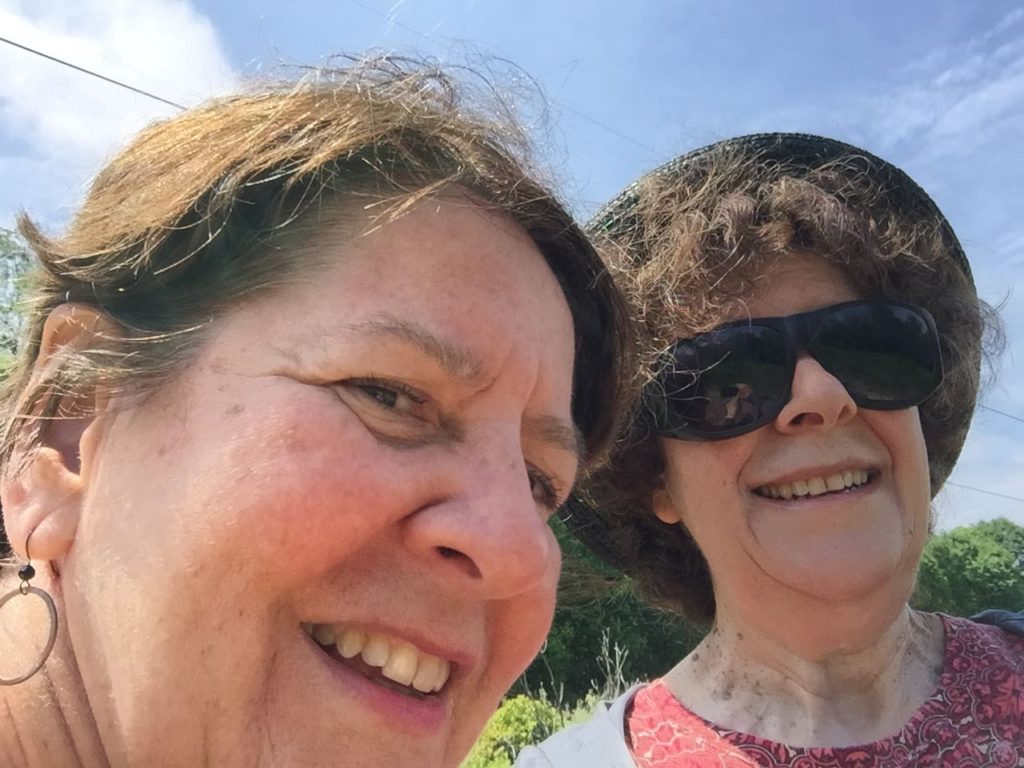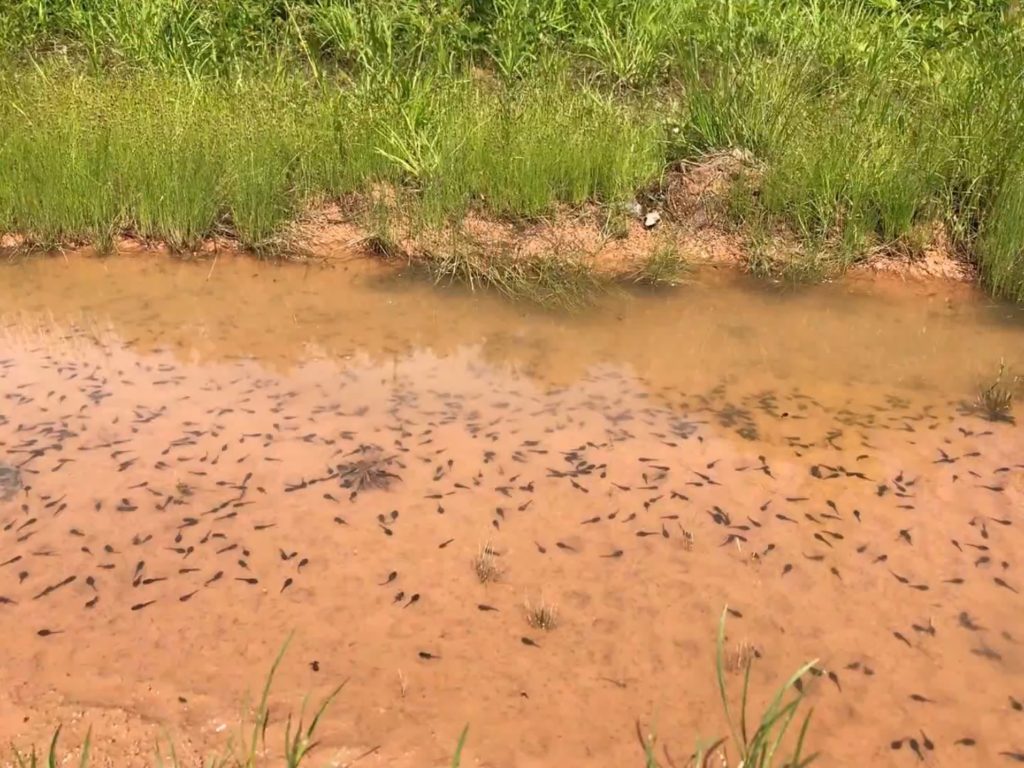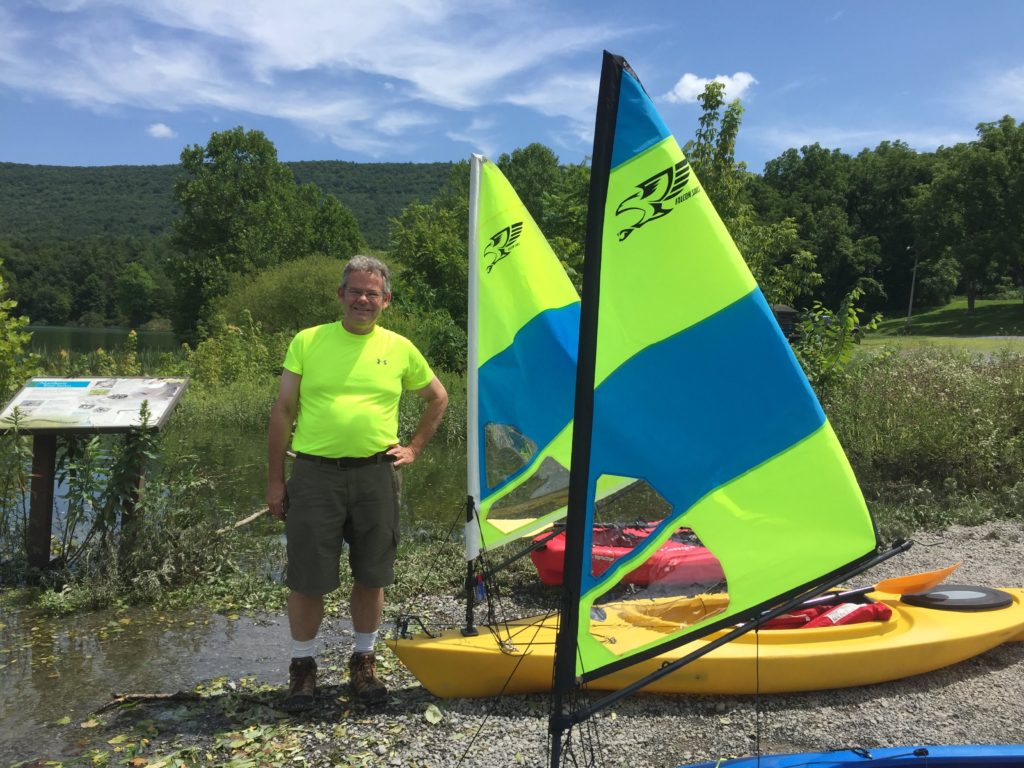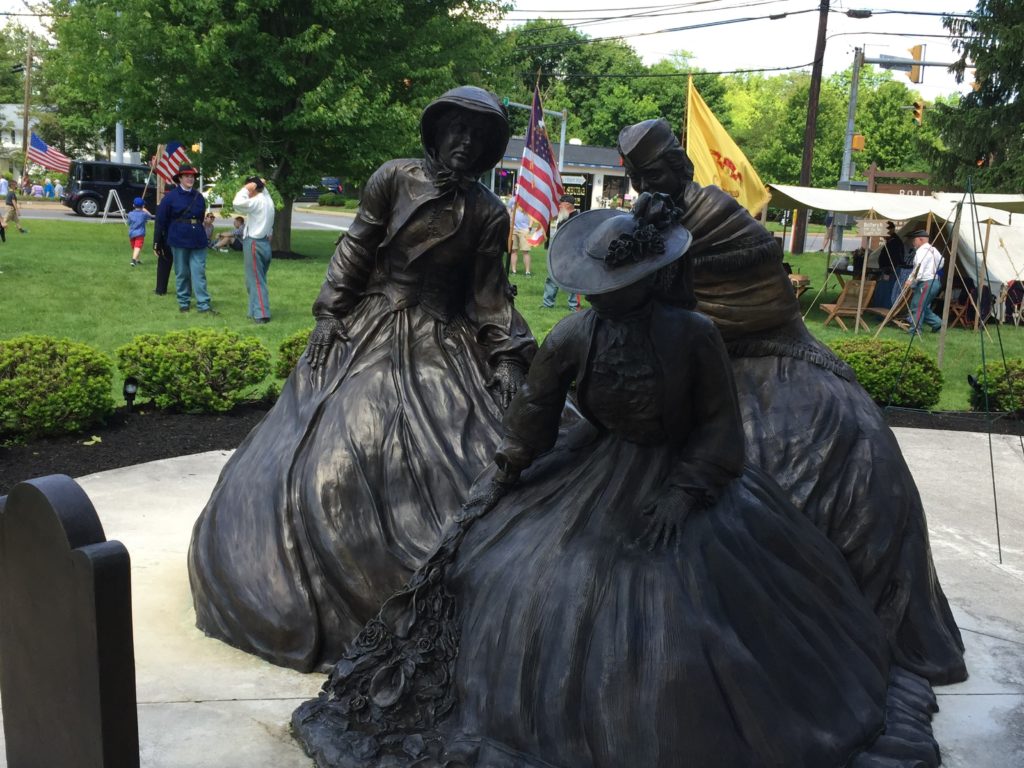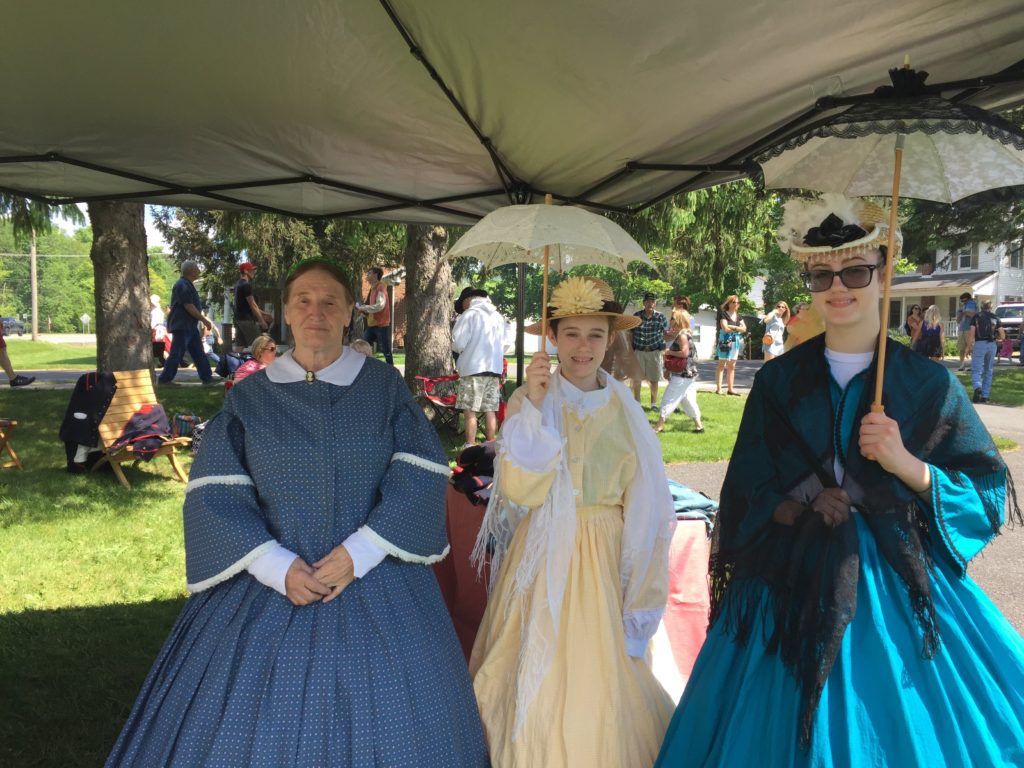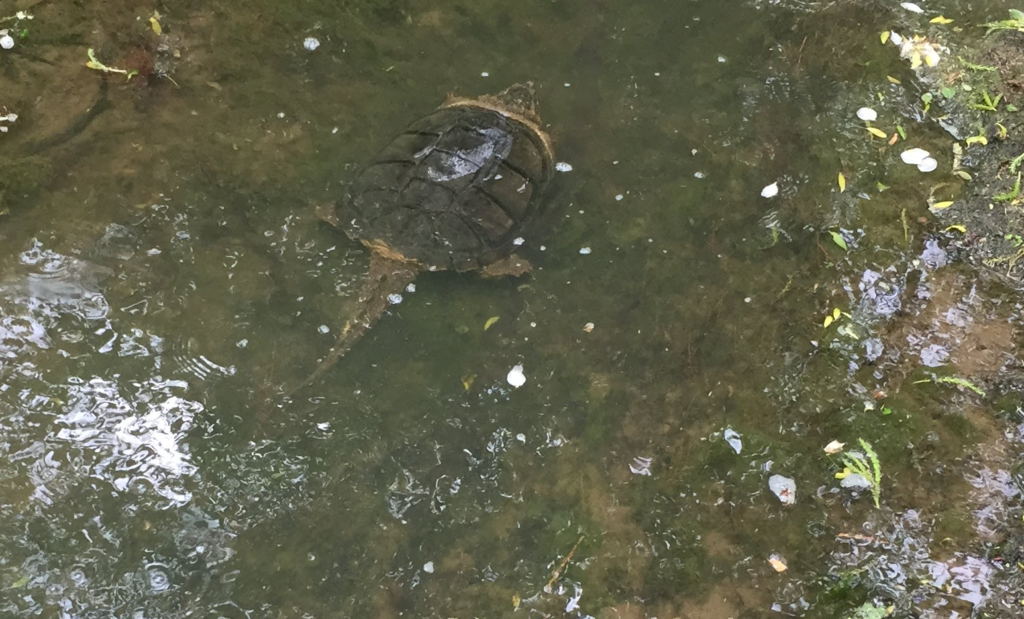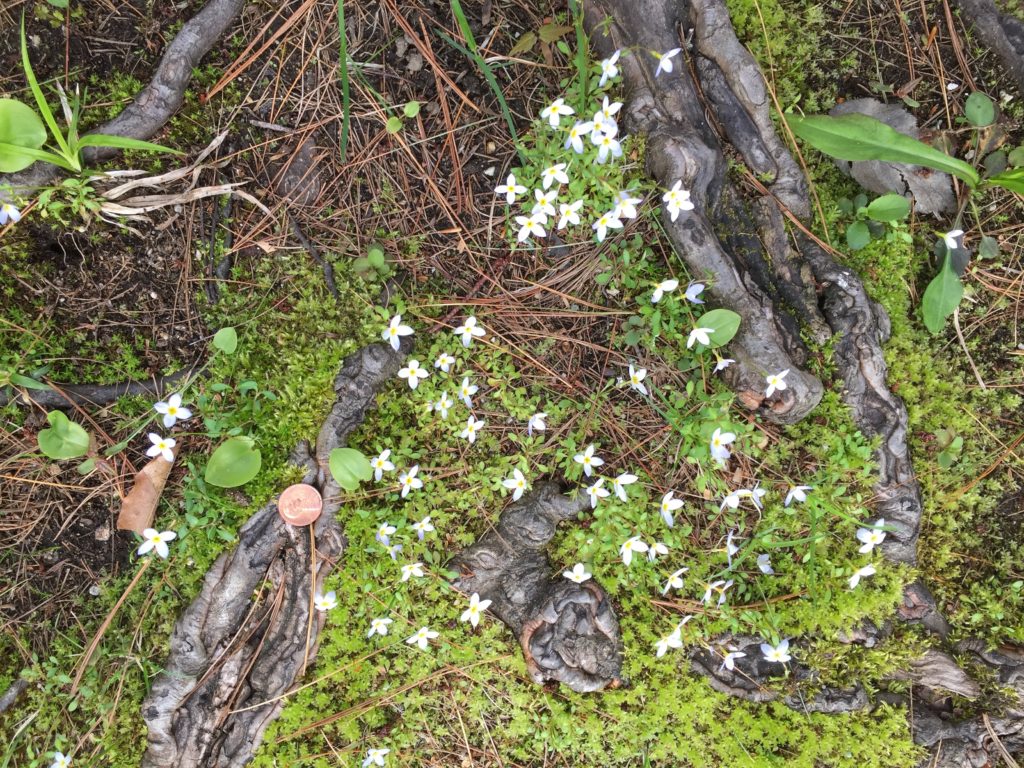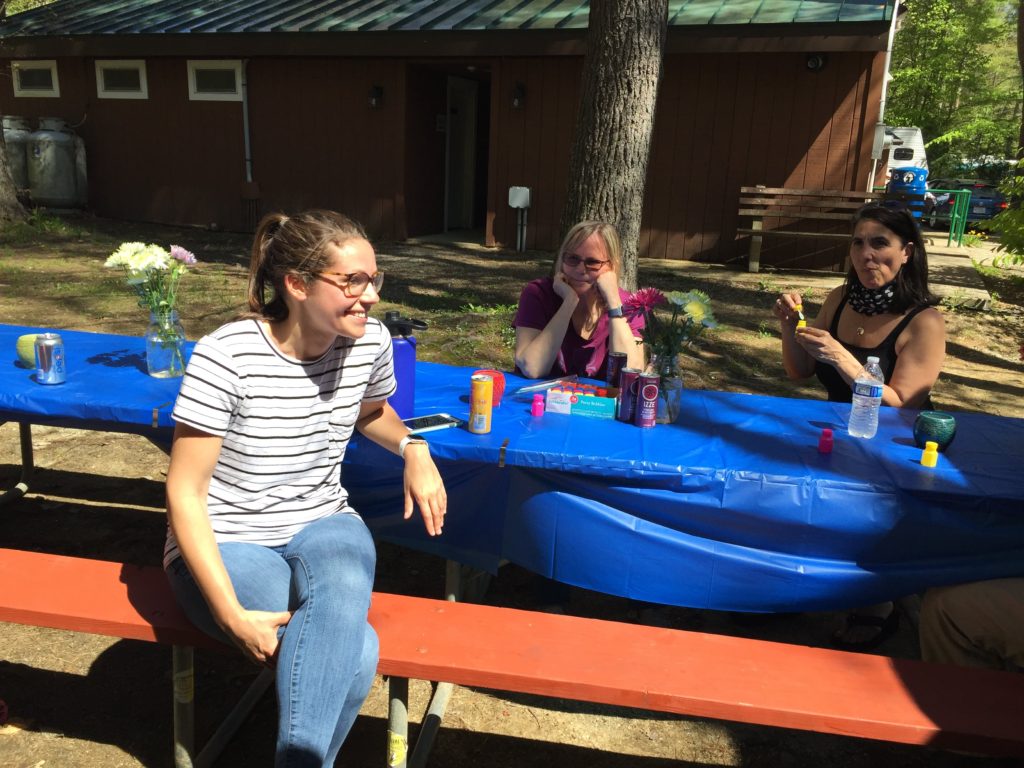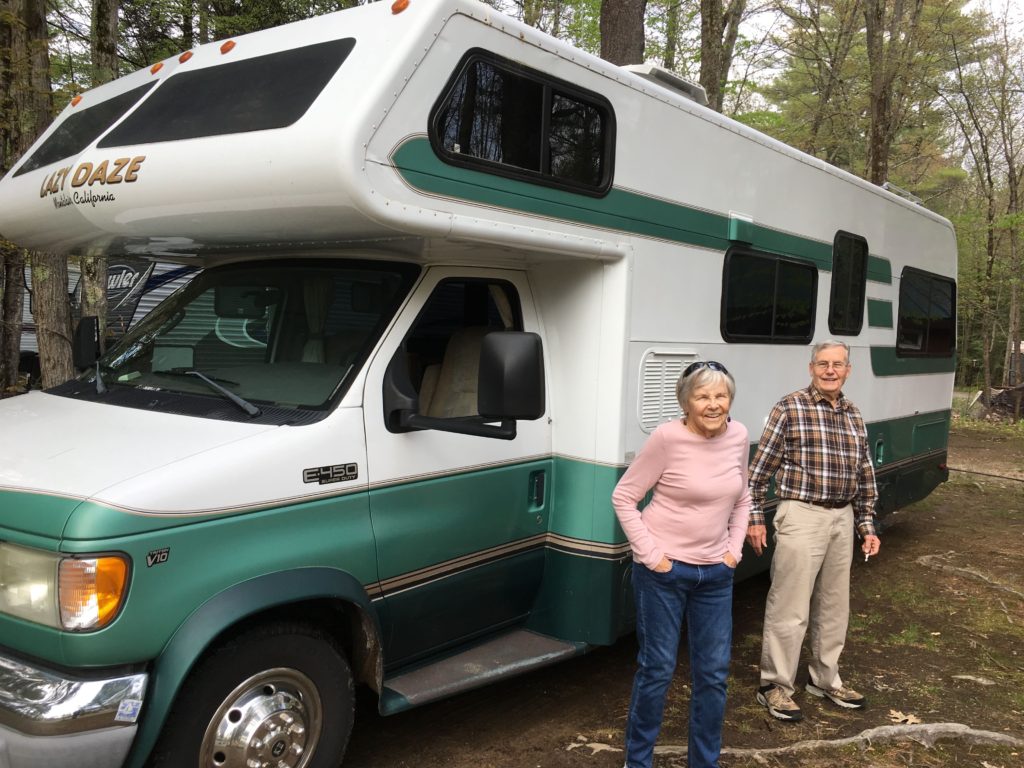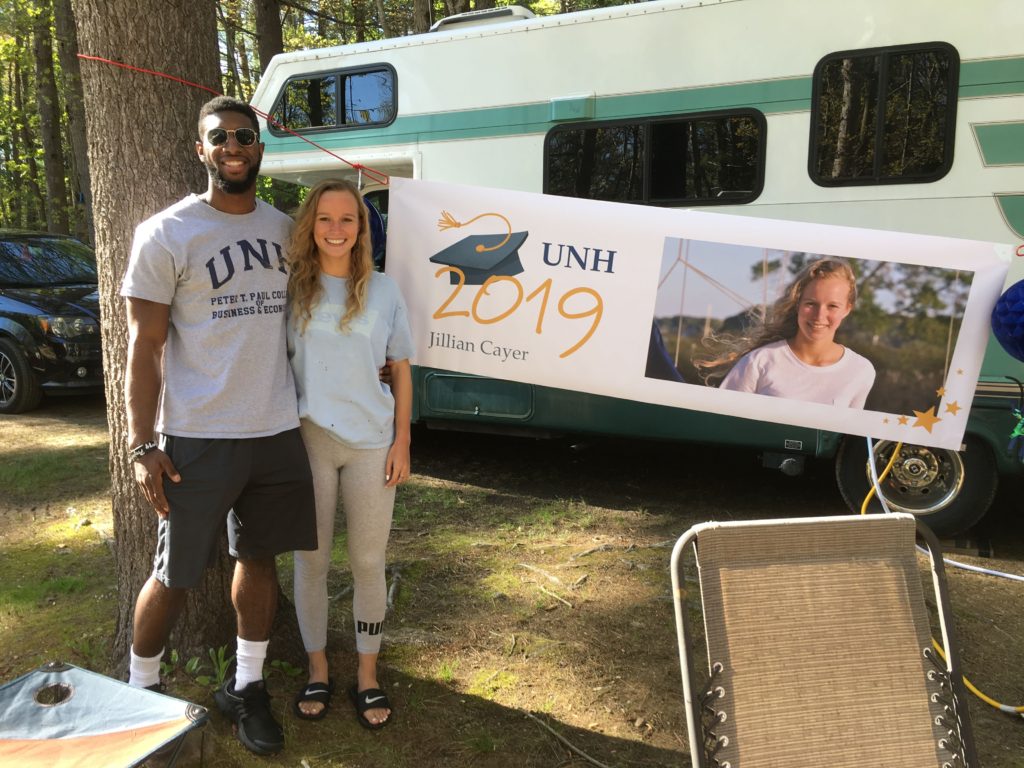Technically, of course, we have already been in Missouri (since we have been visiting St. Louis). However, we were camped in Illinois. The boundary is the Mississippi.
Leaving St. Louis, we need to head northwest to get to Denver. We noticed that there is a route that takes us partly along the west shore of the Mississippi, and then to Hannibal, childhood some of Mark Twain and setting for Tom Sawyer and Huckleberry Finn.
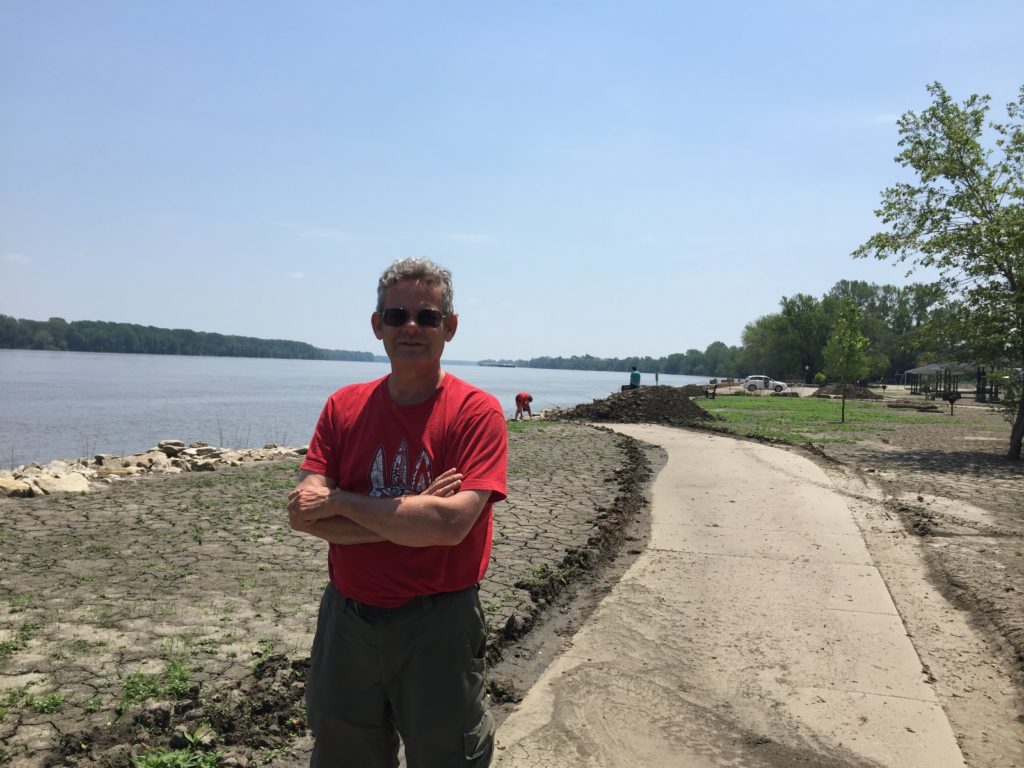
After crossing St. Louis, we missed a few relevant northward turns, but finally got back to the river at Clarksville, MO, a small port town. Clarksville is probably quite lovely usually, with a large park at the base of shipping lock 24.
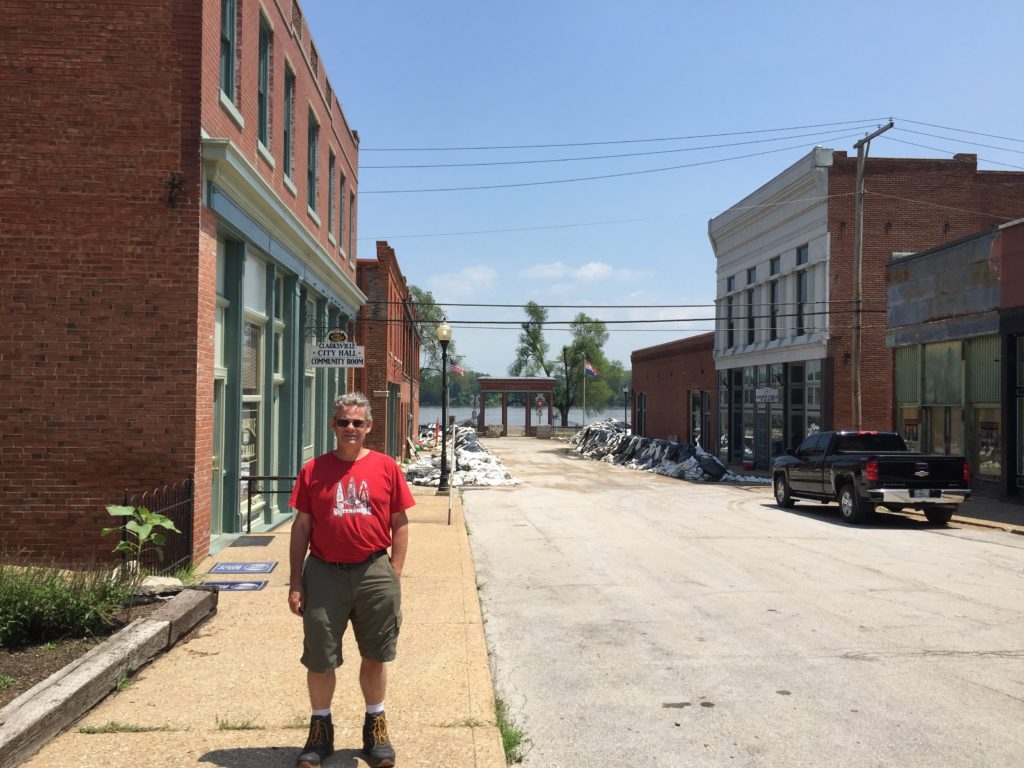
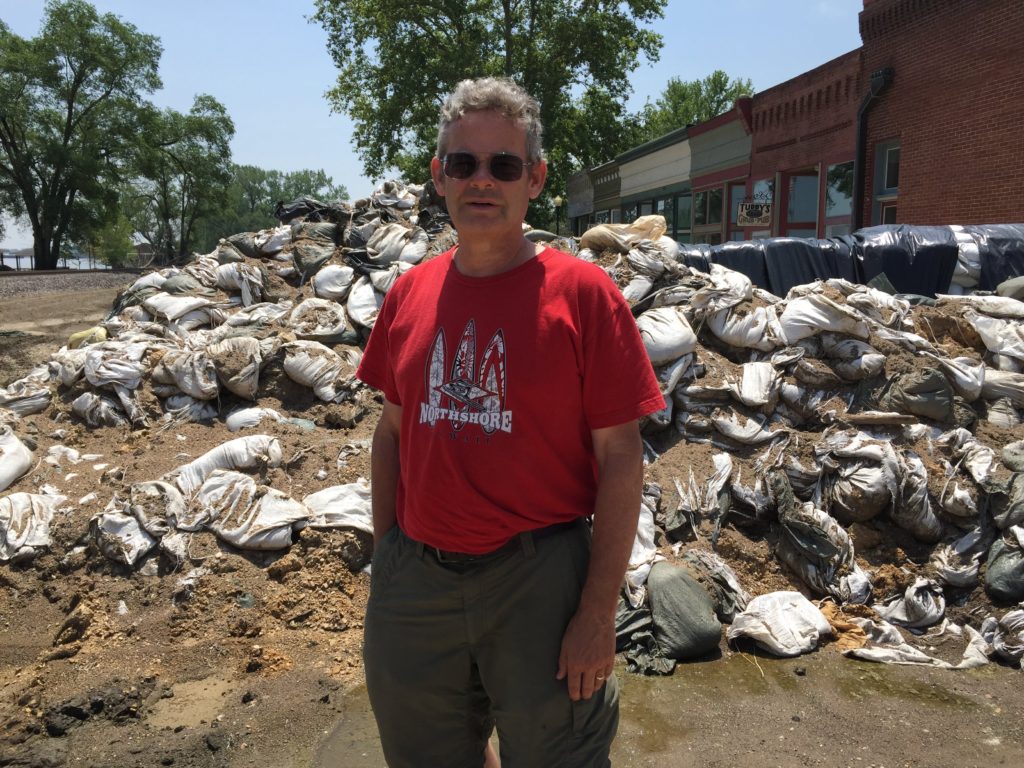
However, the Mississippi has been in flood since March. Poor Clarksville — the downtown is heavily sandbagged. Although the waters have receded, there are huge piles of silty mud that have been plowed off the street and sidewalk. All of the downtown businesses are closed. The waterside park is now dry enough to use, and a few hardy souls were fishing.
We met the owner of an antique shop, who told us that the antiques emporium where she usually sold had been closed since March. Although most of her merchandise was safe, the parking lot had been inaccessible until a couple of weeks ago. She decided to rent a shop on higher ground so that she could generate some income until things dried out in the emporium. She was able to carry out some smaller items by hand-carrying them over boards laid over the wettest spots, and was finally able to get a van in to retrieve some of the furniture. She had treated some items with peroxide to kill mold. It sounded quite miserable. It was not clear if any other tourist shops in town were open. If not, it might be hard to convince people to stop to shop.
She also said that the local church had been open for several weeks to feed up to a hundred sandbaggers, coming from the local prison, National Guard, etc. All in all, not a good time for the town of Clarksville.
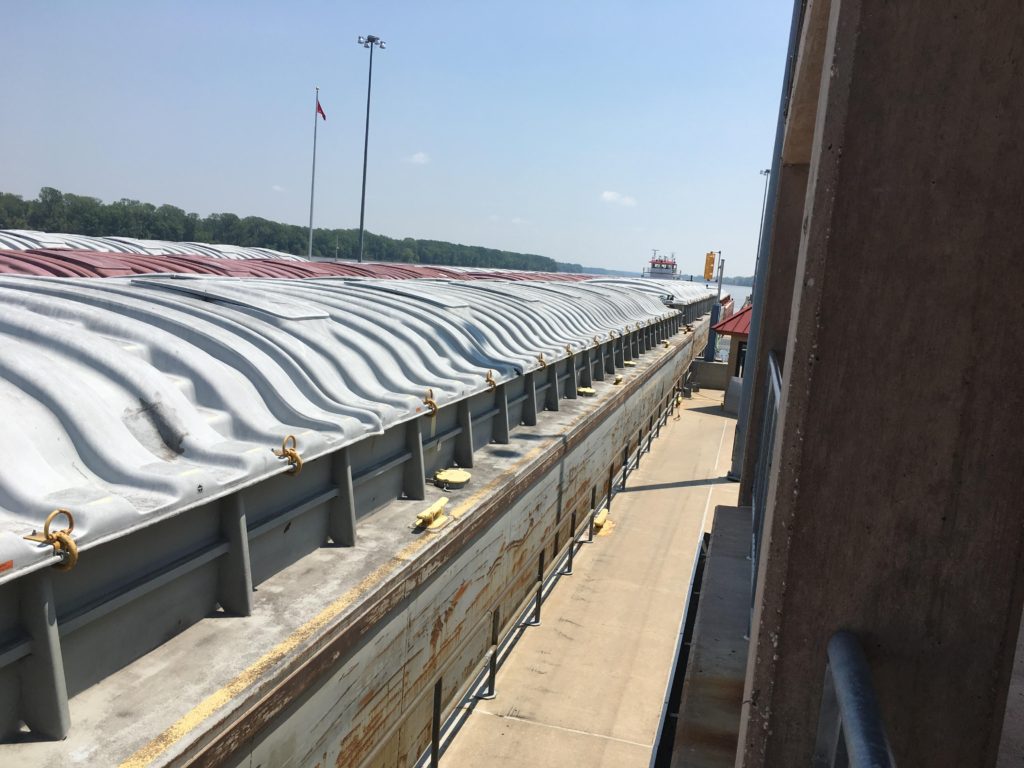
She also directed us a few yards out of town, to barge Lock 24. There we were able to watch a tug push a convoy of 15 huge barges (3 wide by 5 long) into the lock. Since the lock can handle only 3×3 convoys, the barges were decoupled and put through the lock in 2 groups. Since the tugboat (which should be called a pushboat) goes into the lock with the 2nd group, it is not clear to us how the first set of barges gets released — possibly using winches. These barges are mostly transporting cement and gravel. A 15 barge convoy carries the equivalent of 1000 tractor trailer trucks or 225 freight cars. Barges are much safer in terms of both accidents involving injuries and spills, and a quite a bit cheaper. However, obviously they can only move on the river.
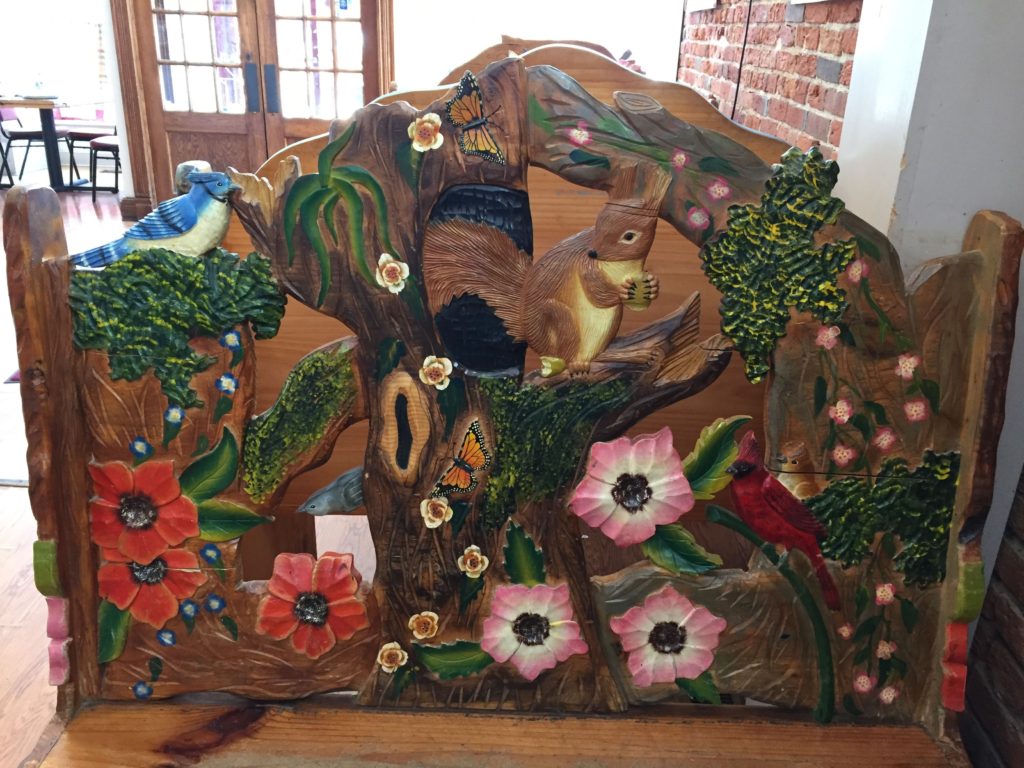
Since everything in Clarksville was closed, we went upstream to the town of Louisianna for lunch. Louisianna sits on higher ground, and seems to have suffered only minor flooding. Everything was open and we had lunch at an excellent Mexican restaurant. Besides the good food, we really like the benches, imported from Mexico.
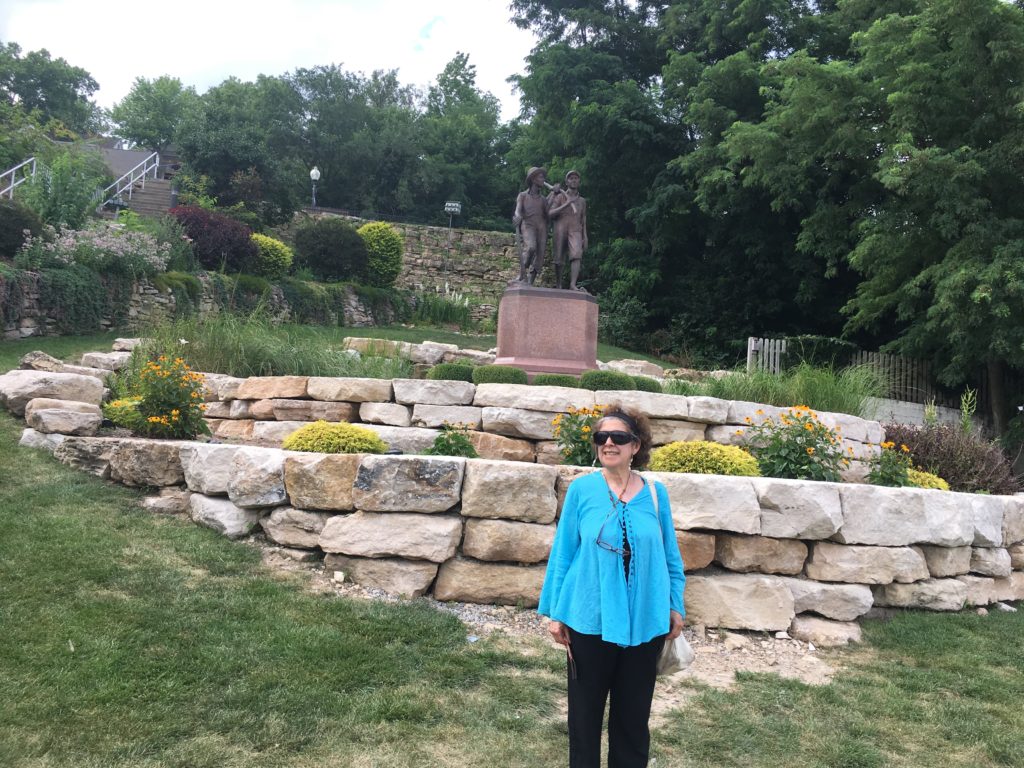
From there we moved on to Hannibal, where we camped at the RV park by the Mark Twain Cave, the cave that inspired the cave scene in Tom Sawyer. We did not visit the cave, but just for the record, unlike the depiction in the book, it does not have stalactites and stalagmites. Needless to say, in the cute historic downtown, almost everything refers to Twain, Tom Sawyer or Huckleberry Finn. We also noted that while Hannibal has a substantial levee, there were another 3 or 4 feet of sandbags stacked on top of it.
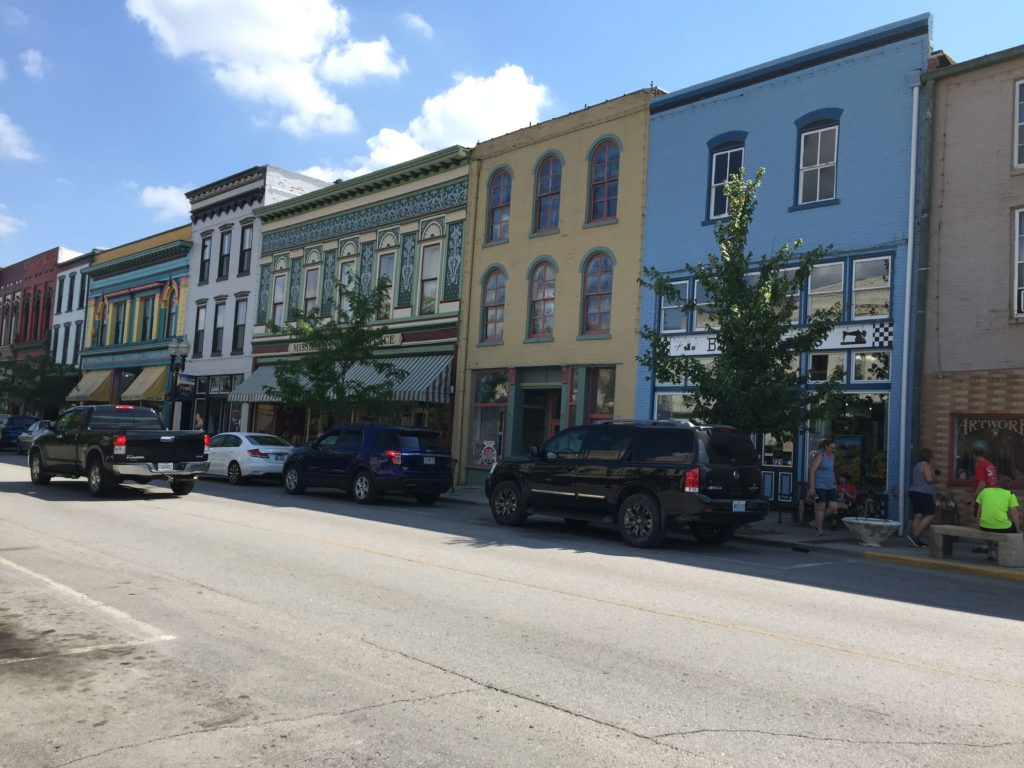
The next day we toured the Mark Twain Museum, which consisted of his childhood home, a museum with a lot of quotes from his books, and a number of restored buildings that included his father’s office and the homes of the childhood friends he said were models for Huckleberry Finn and Becky Thatcher. Twain grew up poor (although not “dirt poor”) and had to quit school after 5th grade when his father died.
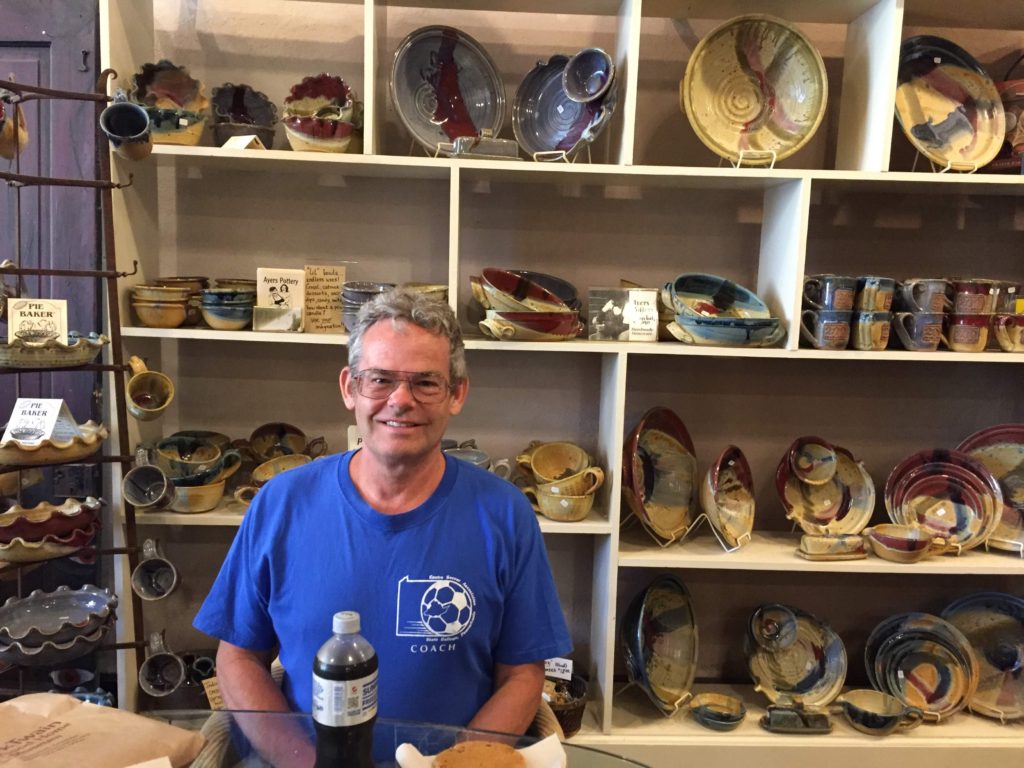
He had a varied career before he started writing: printer’s assistant, steamboat pilot, silver miner and journalist. He was quite a success as a journalist, which led to his being commissioned to write a travelog about Hawaii (which was very successful both in print and as a lecture series) and to go on one of the first sightseeing cruises — a trip through the Mediterranean and the Holy Land. Like his father, he was not very successful in business, so despite the great success of his literary career, he continually had to scramble to stay solvent. He also had a number of personal setbacks. He did a remarkable amount of traveling for his time, living in Missouri, Nevada, California and Connecticut and of course his journalistic travels. He left a huge literary opus, and many notable quotes. One which seems very relevant for our times: ” Suppose you were an idiot. And suppose you were a member of Congress. But I repeat myself.” OK, this is individually unfair — it is the game of politics that ends up with this outcome.
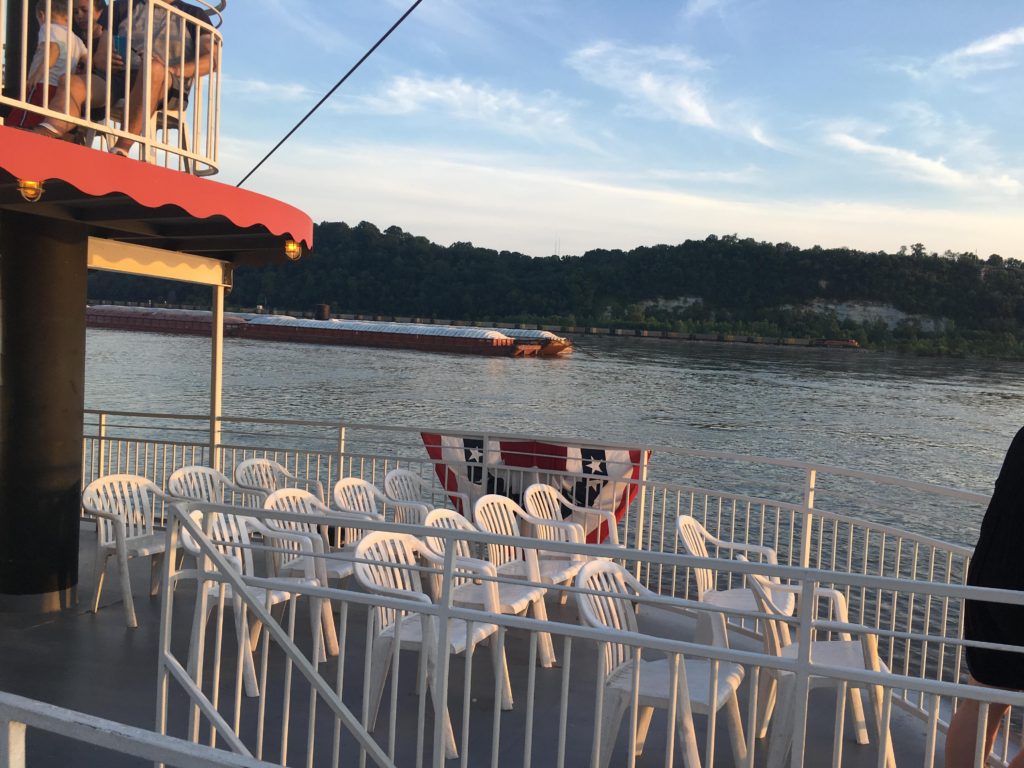
We took the dinner cruise on the Mark Twain Riverboat. The meal was good and the cruise was very nice. We learned a few things about shipping on the river and the relationship between the railroad bridges and the river shipping. (The draw and swing bridges are required to open for boats, but they are operated by the rail companies.) It was a very pleasant evening.
On Tuesday we left for Kansas City, stopping in Macon, MO for lunch. There is not much to Macon, but I felt an affinity for the town, as we had spent time in Macon, GA on our previous RV trip. One thing it does have, however, is a quilting store. Hannibal has two quilting stores. I guess quilting is a popular past-time in this part of the country.
We selected a campground in Independence, MO, just a few miles from downtown Kansas City. What we did not realize until we arrived, is that Independence is of interest in its own right. In the 1830s it was pretty much the most westerly spot in the US. Reachable by steamboat on the Missouri, it was the eastern terminus of the great pioneer trails: the Oregon Trail, Santa Fe Trail, the Mormon Trail and the California Gold Rush trails. Not having had the advantage of playing “Oregon Trail” in history class, Chuck and I were previously unaware of this.
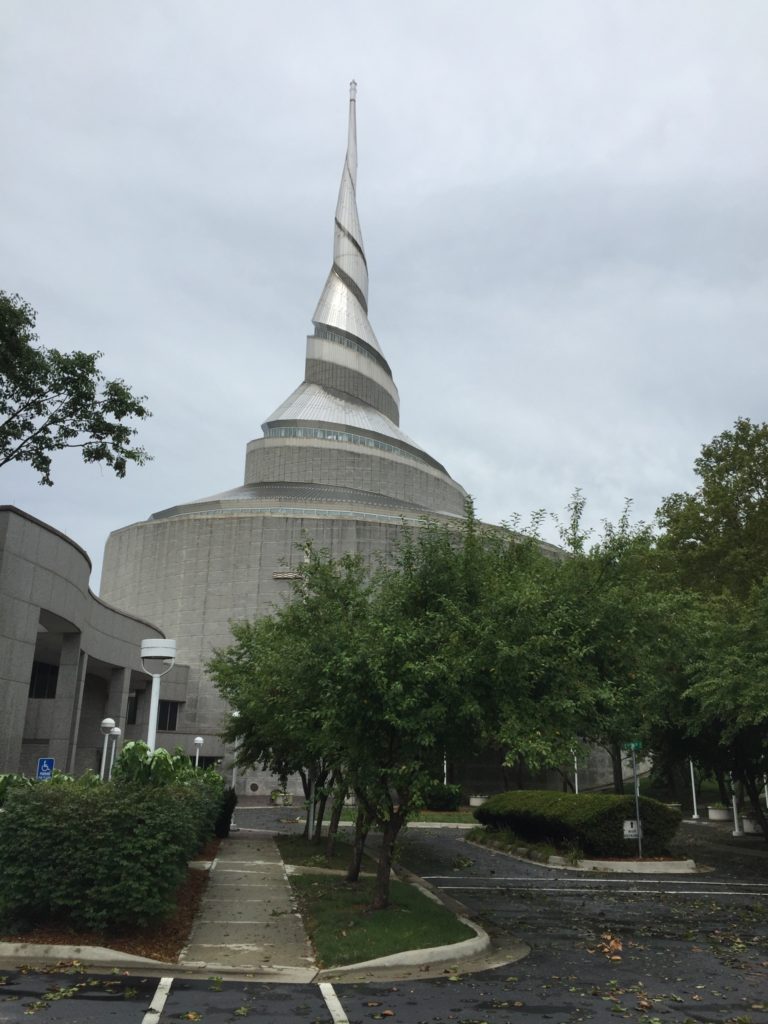
The first hint we had that something was going on in Independence was the sight of this unusual building as we drove into the campground. It is the world headquarters of the Community of Christ, a branch of the Mormon (LDS) Church. It is in Independence because Joseph Smith was inspired to purchase land at the western edge of the US (which was Independence at the time). I don’t completely understand the history here, (but thanks to my friend Ephraim for helping me fill in the details) however after the death of Joseph Smith, there was a schism in the church, with the main branch following Brigham Young on the Mormon Trail to establish Salt Lake City, while the Community of Christ stayed in Independence as well as some of the early sites for the LDS in Illinois and Ohio.
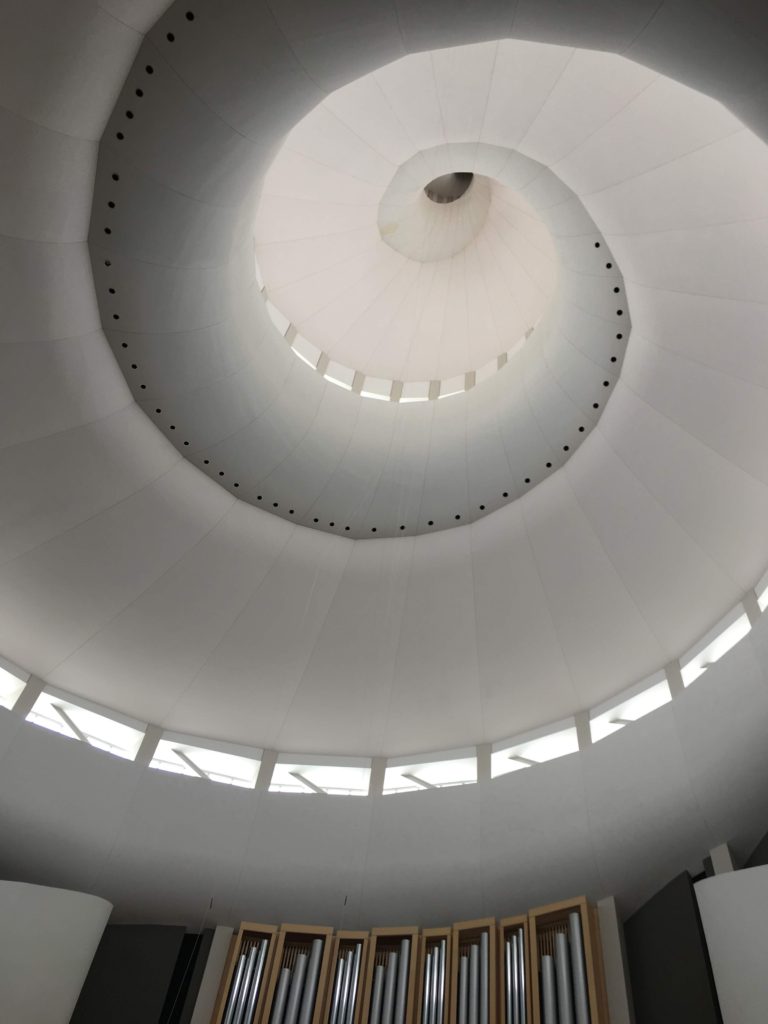
In any case, in the morning, after the end of a torrential rainfall, we set off to see the building, which is both unusual and beautiful. Our tour guide, Wendel, showed us some of the artwork and the interesting spiral architecture of the building. We also visited the main sanctuary. However, this sanctuary is used only for meetings and special occasions — worship is done in smaller congregations. This denomination also seems to be more liberal than mainstream LDS on some issues, such as the ordination of women and people of color.
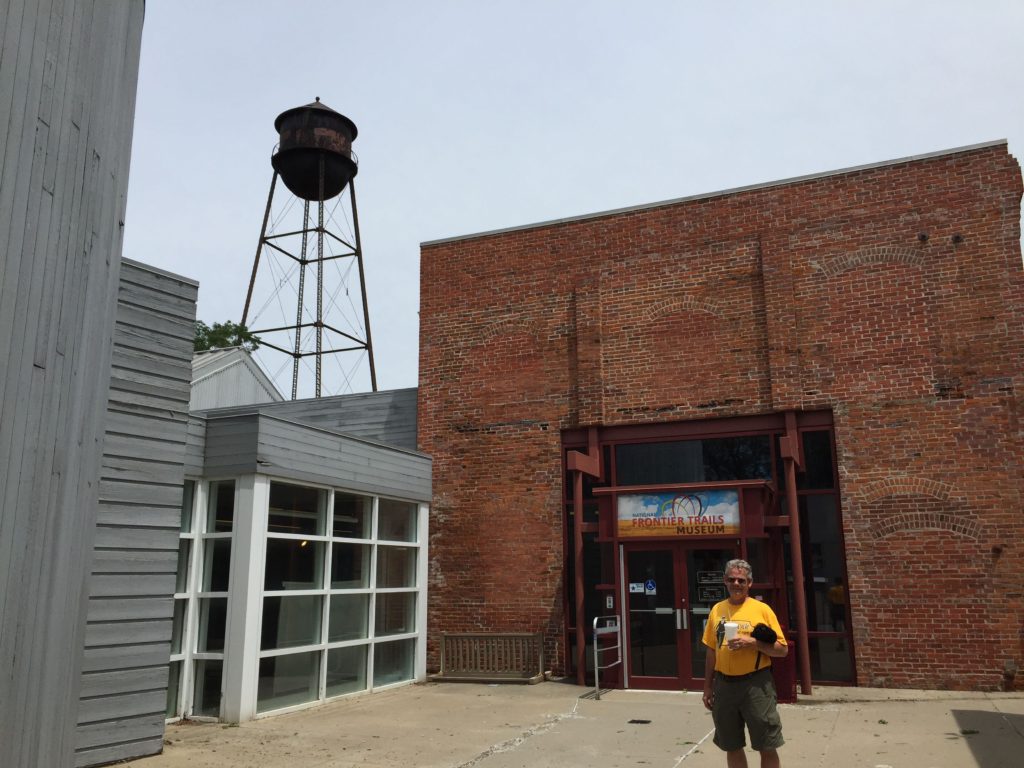
After visiting the church and lunch in town, we went to the National Frontier Trails Museum. This museum explained the various trails and had many excerpts from pioneer diaries, as well as artifacts from the settlers. Among the interesting things we learned were that, despite the many hardships of the trek, about 90% of the settlers actually made it to their destinations. On the other hand, once they reached the mountains they often found that they needed to discard everything except those items actually needed for the trek, so that the trail was littered with cast-off items (not to mention dead oxen, mules and livestock) and the settlers often arrived destitute. The Oregon Trail started in the early 1830s.
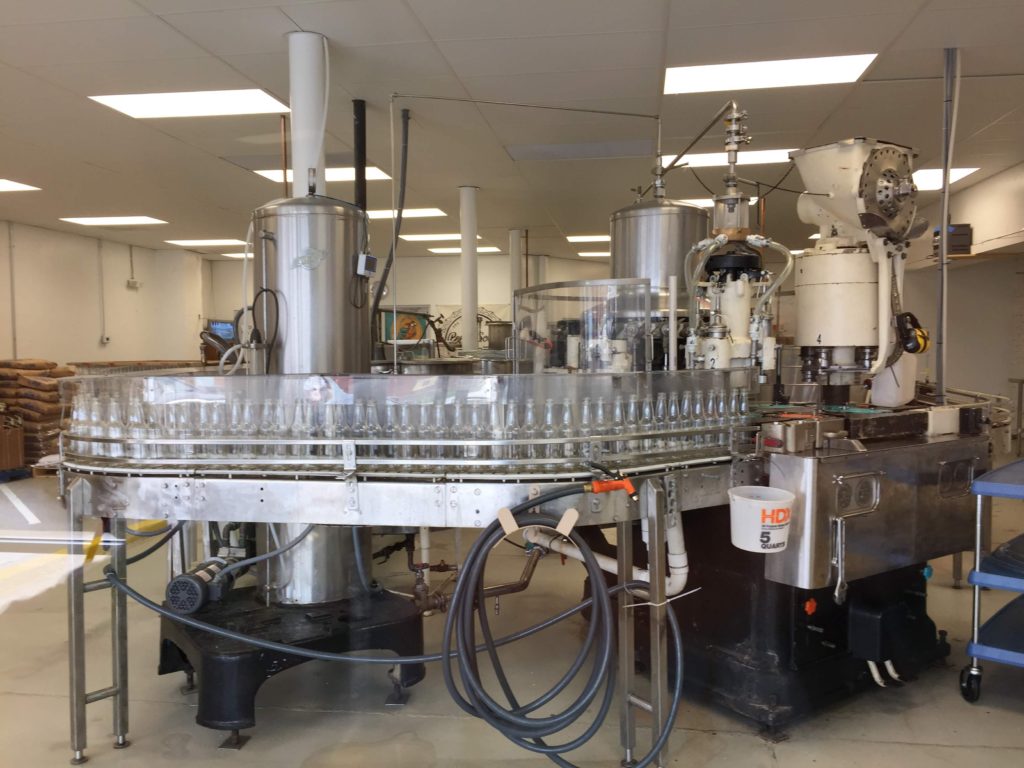
In 1869, the Transcontinental Railroad was completed, reducing what had been an arduous 5 month trek to 5 days of rail and ferry travel. To complete our history lesson, we watched a documentary about the Oregon Trail on TV. (I guess we should have tried the game, too.)
Independence also has its own local soft drink, Polly Pop. The bottling operation can be viewed through the front window.
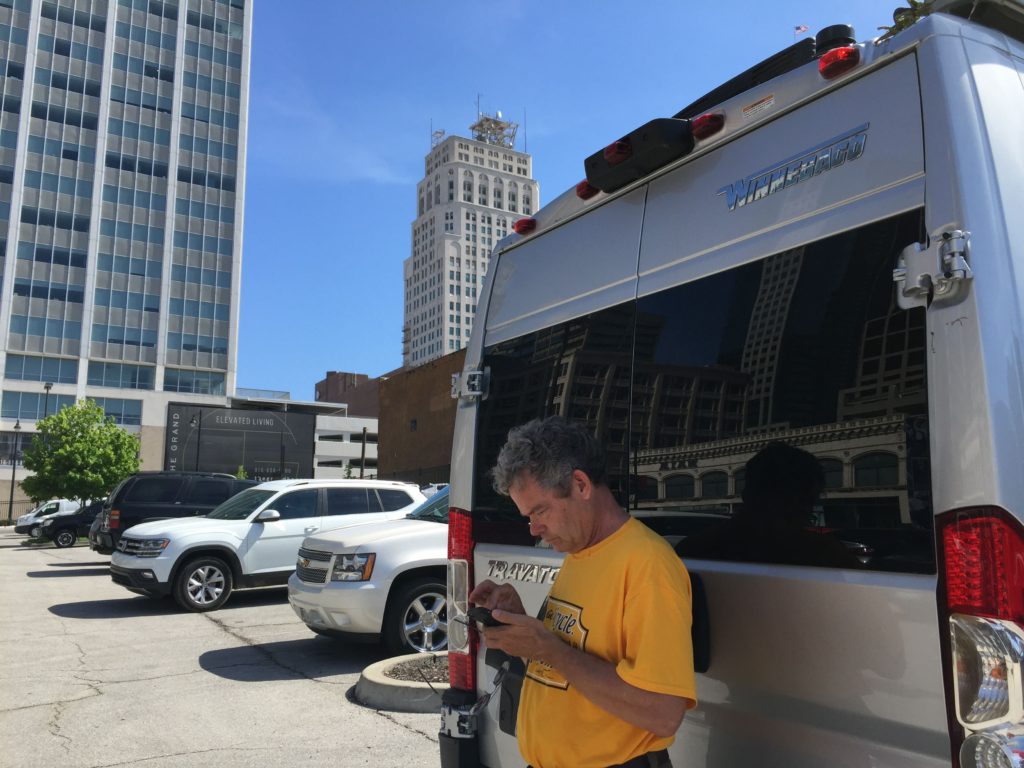
On Thursday we drove to Kansas City and parked in a downtown lot. From there we walked to the City Market a fairly substantial and not very interesting trek which we could have avoided by either parking near the Market (lots of space) or taking the free KC trolley, which runs between Union Station and the Market. It is still a novelty to us to be able to park our RV almost anywhere. (Although to be fair, KC has RV parking suitable for large RVs at the City Market — if you are up for driving the RV into town.)
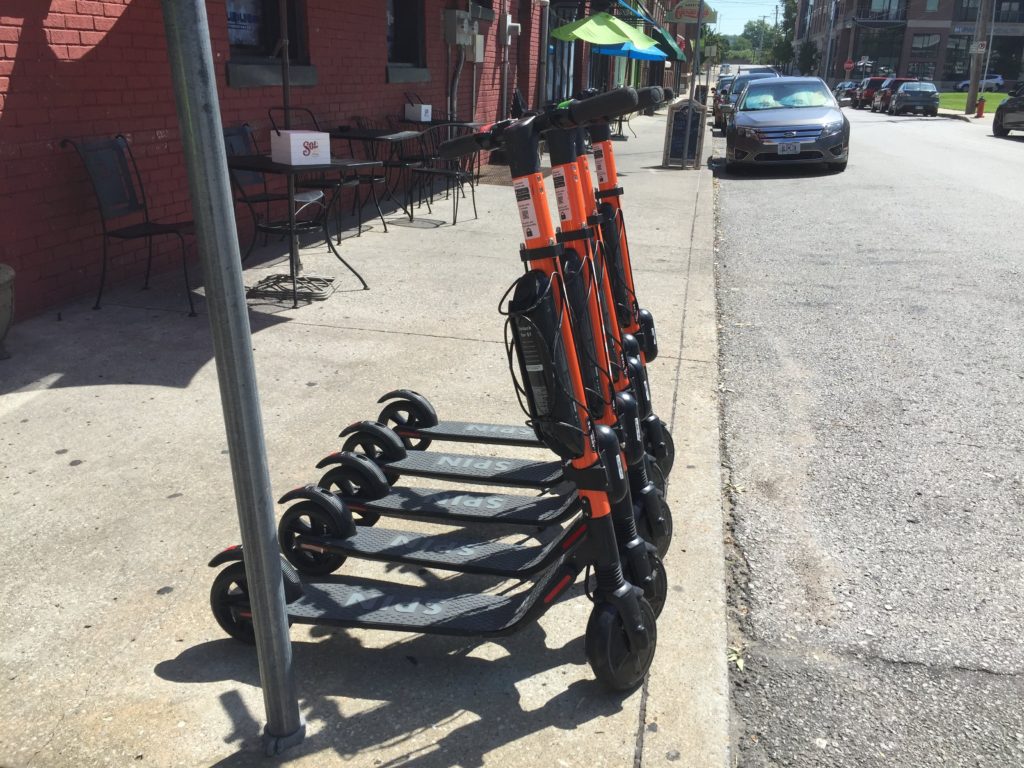
We first noticed these in St. Louis, but they appear to be popular everywhere in MO — scooter shares. In downtown St. Louis they are everywhere, and people seem to drop them wherever they are, rather than at regular stands. It is pretty common to see a couple sharing a scooter, too. We did not try these out.
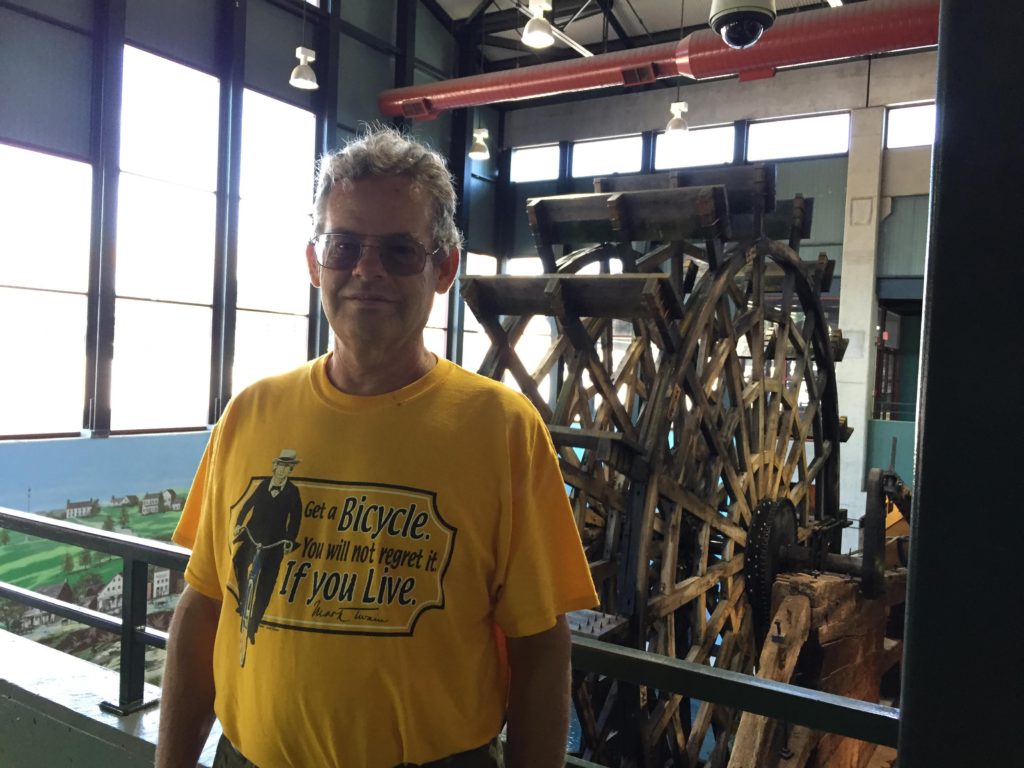
Our first stop was the Steamship Arabia Museum, which we found very interesting. Steamships were the preferred mode of travel from 1819 until the completion of the Transcontinental Railroad.
Due to the meandering nature of the river and increased erosion of the banks which were deforested to provide fuel for the steamship boilers, creating lots of snags and stumps, over 150 steamers are known to have sunk on the Missouri. The average lifespan of a Missouri steamship was less than 5 years.
Since the Missouri river bottom is sandy in most places, the rapid current pulled sand out from beneath the wrecks, which were then essentially buried in the river bottom. However, due to the meanders, the course of the river changed a lot over the years and was only stabilized when the Army Corps of Engineers was tasked with creating a permanent channel. As a result, many of the wrecks are now not under the river, but under fields.
The steamship Arabia sank in 1856 when a submerged stump stove its hull. The impact was abrupt. Fortunately, the only casualty was a mule that was left tied to the ship. The passengers even managed to bring much of their baggage off the boat — unfortunately for them much of it was stolen. The cargo, however, went down with the ship.
In 1987, 5 men from Independence decided to try to excavate the wreck of the Steamship Arabia, which was known to be located in a field. A previous attempt to excavate the wreck to recover several hundred barrels of whiskey was terminated when the recovery crew found only boots and other dry goods. The 1987 dig was a major effort that took place over a single winter when the field was not needed for crops and freezing weather helped stabilize the walls of the excavation. They put down probes that found the outline of the ship and starting digging. The ship was about 40 feet down, but the water table was only 10 feet. They used a lot of pumps, and worked wet despite the cold weather. It turned out that the cold had another advantage, though — it helped maintain the integrity of the artifacts.
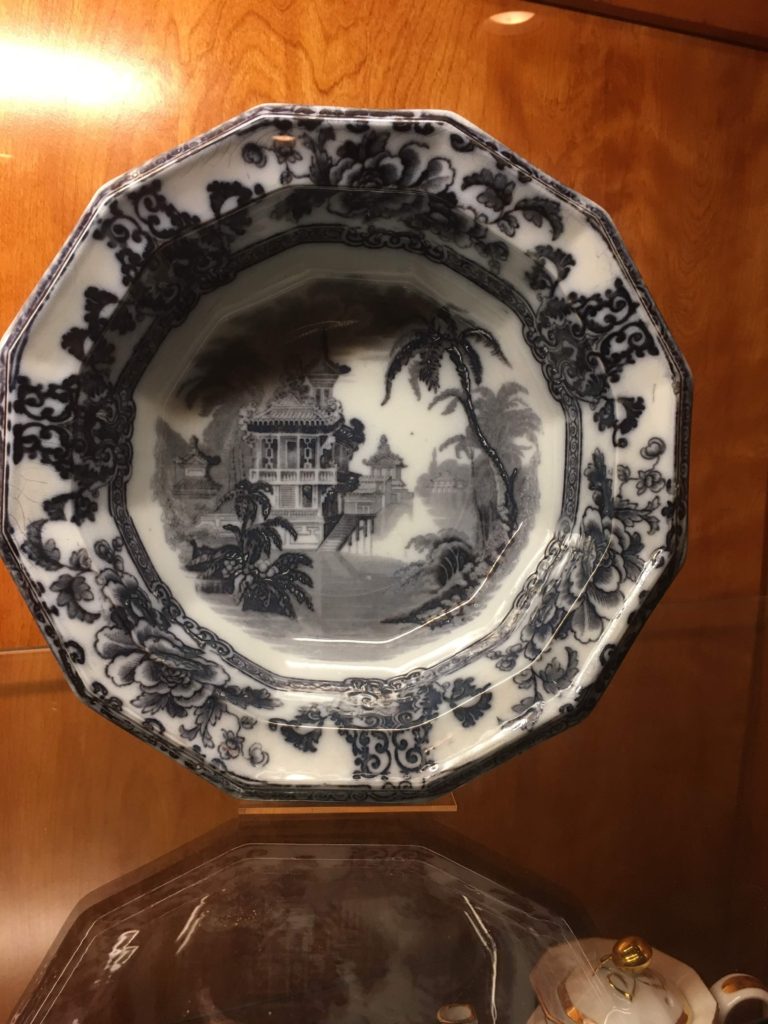
The first cargo that they found was a barrel filled with fine china. This spurred their efforts. It turned out that the hold was filled with barrels of trade goods, from glass trade beads to jars of pickles. Anaerobic conditions in the Missouri mud had preserved almost everything except cotton. Leather boots fell apart due to the lack of cotton stitching, but the leather stayed intact.
The original intention had been to sell the cargo, but when the wealth of goods was revealed they decided to open a museum instead. This turned out to be fortunate, because according to our tour guide, some of the goods were in such pristine condition that they would have been flagged as fakes by dealers.
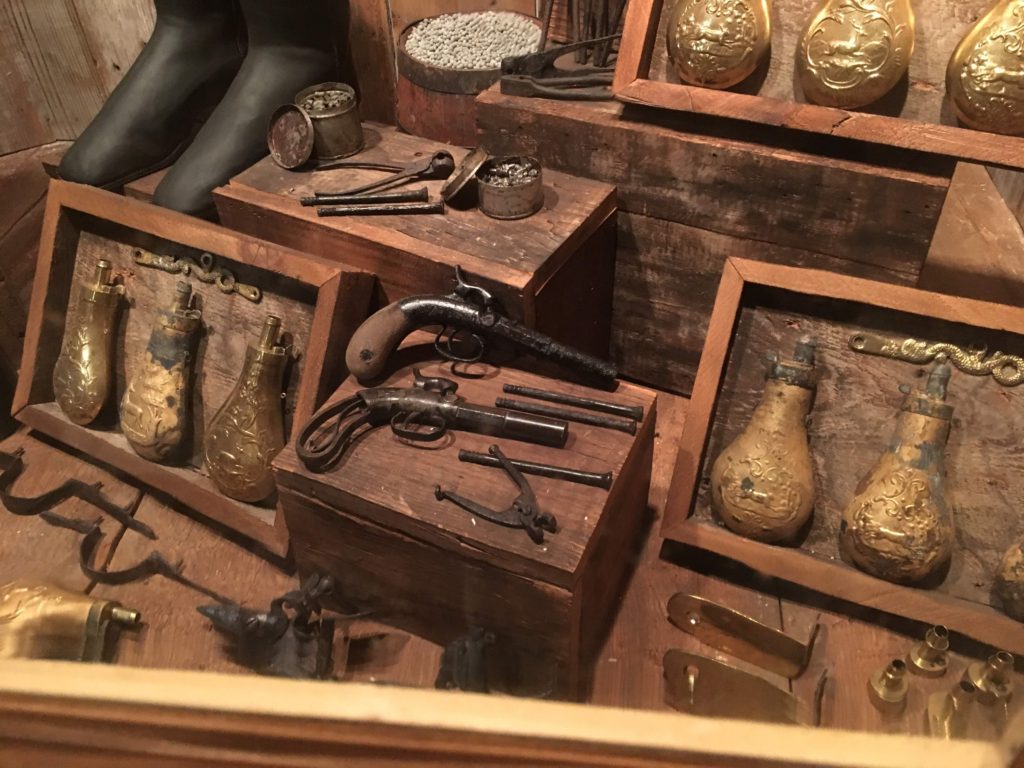
The families, all amateurs at archeology, contacted museums in the US and Canada to learn how to clean, preserve and display the artifacts. Fortunately, one of the men had owned a restaurant chain that had a large number of freezers in which they used to store their meat. Everything that needed special handling was placed in the freezer (in Independence) until it could be processed. In particular, wooden items needed to have the water replaced by a plasticizing agent. All of the cargo, one of the paddle wheels, some of the hull and decking and the stump were recovered. The rest was reburied in time to use the field for spring planting.
Everything that has been cleaned and restored is in the museum — no matter how many duplicates, etc. As well, the restoration lab is in the museum. The owners are often present and are happy to chat about the recovery and restoration. They are now planning to dig up another steamer.
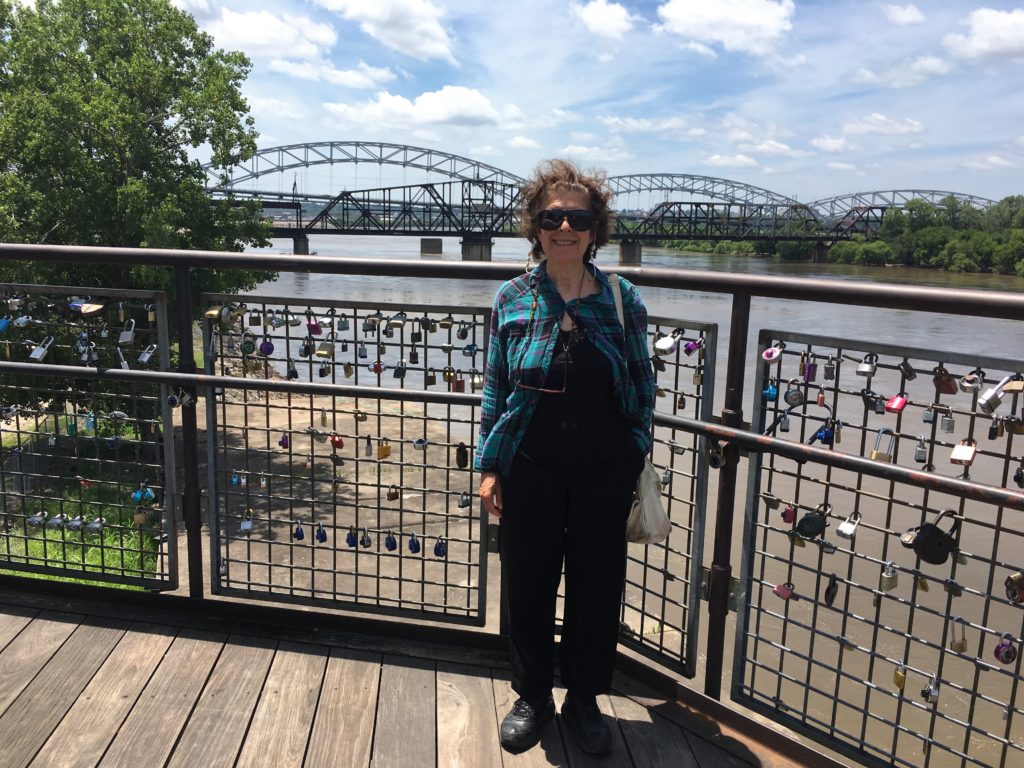
The Steamship Arabia Museum is in one of the buildings for the Central Market. On a weekday, only the restaurants and a few ethnic food stores are open. We had lunch at a Brazilian place and then walked to a spot where you get a view over the Missouri.
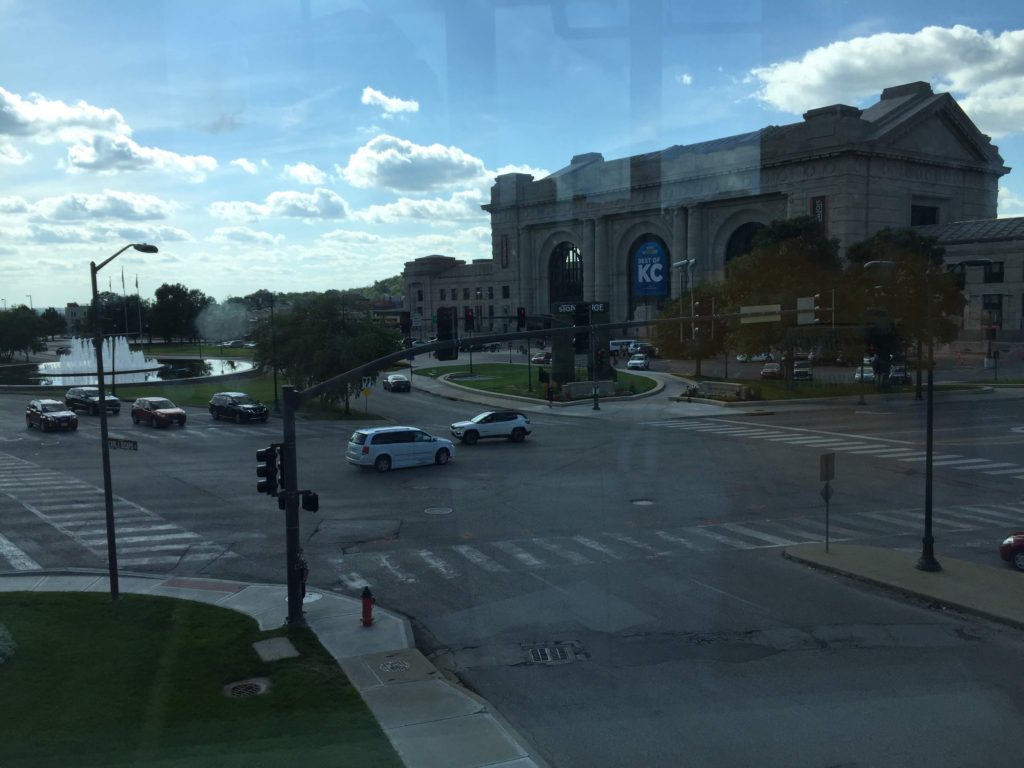
We had hoped to take a walking tour of downtown, but noticed rather late that it was not offered that day. As a result, we also missed our opportunity to take a trolley tour. Instead, we walked downtown towards the old train station. Part way there we found the tourist information center. They told us about the free downtown trolley, and since it was very hot and humid, we hopped on for a ride to Union Station. The station looks much like train stations of similar era in the east, i.e. majestic. However, the vast majority of train traffic is freight and so there is little need for a passenger station right now. The space has been converted into shops, a science museum and an event venue.
Across the road in one direction is the monumental WWI memorial. It was still very hot, so we did not climb up to get a closer view. Instead, we took the glassed in pedestrian walkway that crossed two streets to a large hotel and mall complex. It was rather like walking through an oven. The complex includes an aquarium, Legoland and the Hallmark Museum. These were all closed due to the hour, although the shops were open. As well, the hotel offered a cool atrium with a 2 storey waterfall.
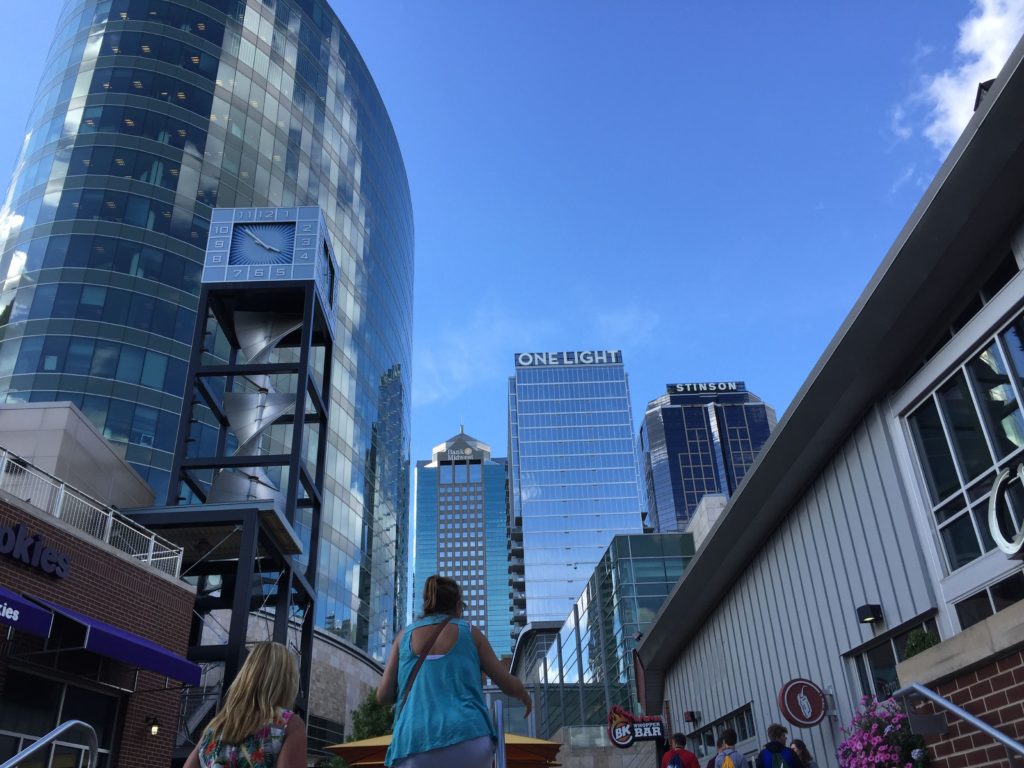
We hopped on the trolley and got off near our parking spot. There was an open-air concert in a restaurant area. It seemed very peasant, except that the volume made us want to sit several blocks away. We opted instead to return to the campground We were amused to note that our parking lot, which was $7 for all day parking, was charging $15 for event parking. I am sure everyone looking was a parking space was glad to see us go — although it took a traffic cop and the lot attendant to get us out and back on the street due to all the congestion in the lot and the signage that was blocking the exit.
I am giving 2 talks at the Joint Statistical Meetings at the end of the month and was getting a bit frantic about preparing them. So, on Friday we stayed at the campground in Independence. I worked most of the day, and Chuck rested. However, I could not leave Independence without seeing its most unique museum: Leila’s Hair Museum.
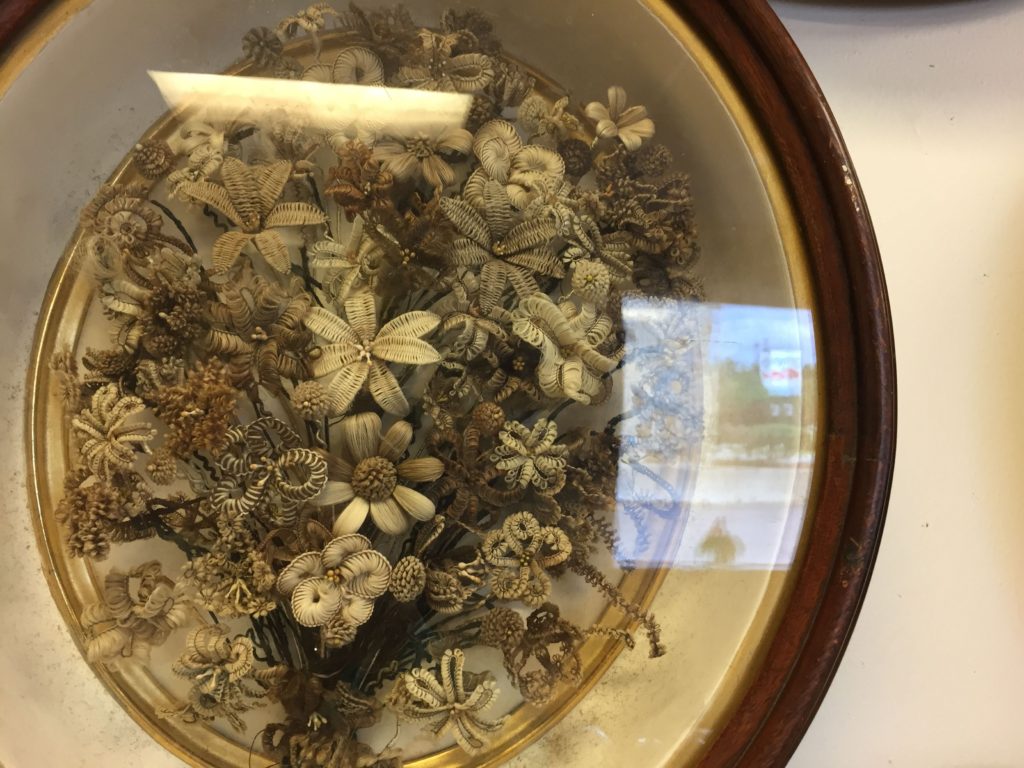
Leila is a hair dresser, beautician … She was out shopping in 1957 when she spotted a hair wreath. Since then she has collected dozens of wreaths and many other hair items such as jewelry. This is a craft that was popular in the mid to late 1800’s. I associated it with Queen Victoria using the hair of her deceased but beloved husband Albert in jewelry. However, it turns out that hair art was a popular way to commemorate events, a popular gift from wife to husband, and even just a way to make apparel. Hair is durable.
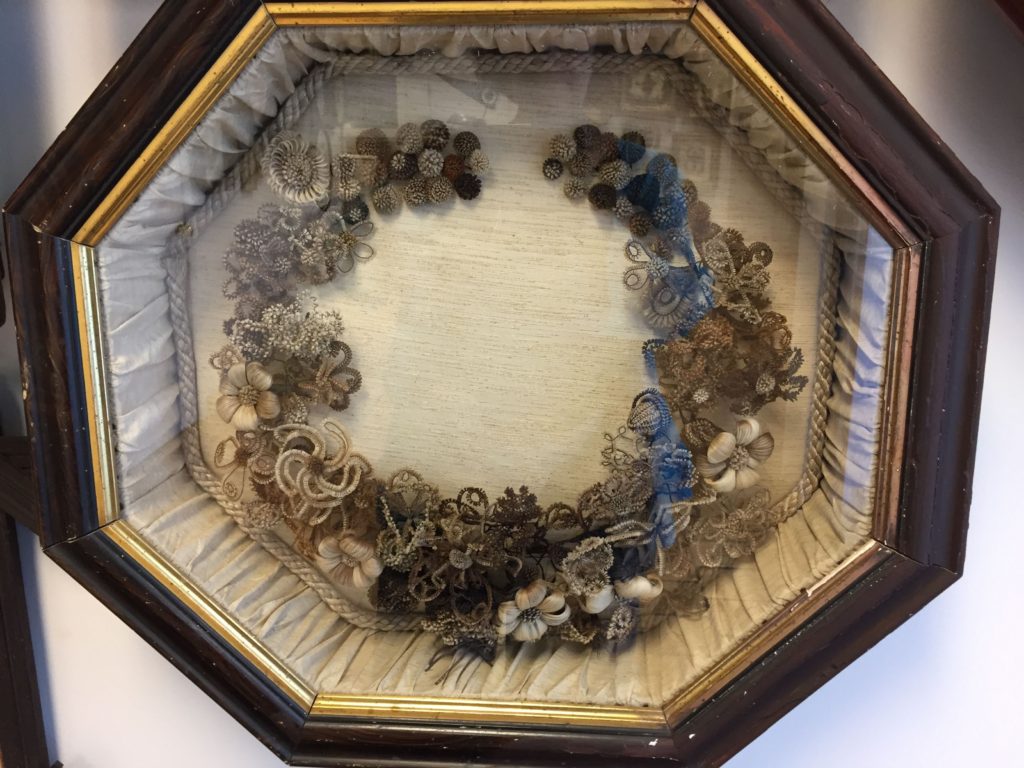
It can be braided to make watch fobs, necklaces, rings etc. Combined with wire, it can be crocheted into flowers and leaves. Lacquered it can be cut and used for decoupage. It can even be powdered and mixed with paint. And of course locks of hair can be added to photos or enclosed in a locket. For the last 60 years, Leila has been collecting examples, some very intricate, of hair art and displaying it in her museum. I have to say that a couple of examples would have been fascinating — in such bulk it was overwhelming. Since we were escorted by a guide (a woman whose roots are in Tyrone, PA) I stayed for the entire tour.
Here are a couple of interesting factoids, though. Hair wreaths were always open at the top to keep good luck in. And the frames, which are deep and often lined with silk or other luxurious fabrics, were often made by the local coffin manufacturer.
After the museum, I went back to the RV to work and ended the day with both talks more or less planned out.
